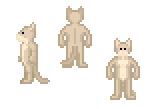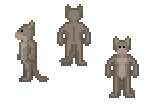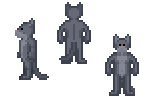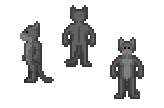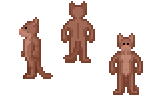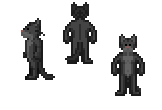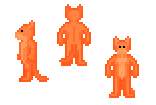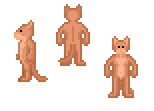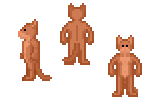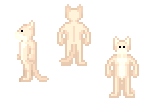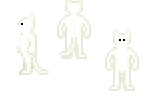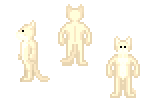Tajara: Difference between revisions
→Social: Nature of the Second Self Lore Canonization update |
|||
| (14 intermediate revisions by 6 users not shown) | |||
| Line 3: | Line 3: | ||
{{Infobox Species | {{Infobox Species | ||
|Species = Tajara | |Species = Tajara | ||
|Scientific = T. | |Scientific = T. sapiens | ||
|Image = OldTajara.png | |Image = OldTajara.png | ||
|System = S'rand'marr | |System = S'rand'marr | ||
| Line 33: | Line 33: | ||
* Research Director | * Research Director | ||
* Chief Engineer | * Chief Engineer | ||
* Operations Manager | |||
* Consular Officer | * Consular Officer | ||
* | * Corporate Liason | ||
M'sai can be the following Heads of Staff: | M'sai can be the following Heads of Staff: | ||
| Line 56: | Line 57: | ||
* Tajara have a set of organs adapted to the life on Adhomai, with some differences in regard to function and form. | * Tajara have a set of organs adapted to the life on Adhomai, with some differences in regard to function and form. | ||
* Due to a long history of combined selective breeding and cultural factors, different Tajaran races have different physical qualities and attributes as well as levels of education. Visit the physiology sections of the [[Tajaran Ethnicities]] page for information about their differences. | * Due to a long history of combined selective breeding and cultural factors, different Tajaran races have different physical qualities and attributes as well as levels of education. Visit the physiology sections of the [[Tajaran Ethnicities]] page for information about their differences. | ||
== Biology == | |||
To the average human, the Tajara share many similarities with Earth's felines; however, when looked at from a purely scientific perspective, this description is largely superficial. Unlike terrestrial felines, the Tajara are both omnivorous and bipedal. Their bodies are almost entirely covered in a thick coat of fur that is extremely good at insulating them from the extreme cold of Adhomai. The layer of body fat and fur is designed to trap body heat efficiently. There are only a handful of areas where fur is not present, those being on the palm of their hands, the soles of their feet, and a number of various orifices as well as a small area around their eyes. Tajara have nictitating membranes, a transparent eyelid layer that assists in preventing snow blindness and keeping their eyes moist against the wind. | |||
Occasionally, the fur around a Tajara's neck is known to grow into a shaggy 'mane' of sorts, giving them a distinct look, not unlike a terran lion. This hair tends to be much stronger and a great deal wirier than the rest of the fur on a Tajara's body. Some Tajara tend towards monochromatic bodies while others have multicolor or even calico fur patterns. These designs depend heavily on the genetics of the individual's parents, much like hair and eye color. Because of this, some parents are utterly incapable of producing multicolor children. Designs including flat colors, stripes, spots, and most conceivable combinations have been recorded by scientists both Tajaran and human. A male Tajara is somewhere between 150 cm and 185 cm in height, while the mean body mass is between 65 kg and 100 kg. Females tend to range between 150 cm and 175 cm in height, with their own weight somewhere around 45 kg to 85kg. As such, both their body weight and height are roughly comparable to the average human. Height depends on a Tajara's ethnicity. Njarir'akhran were bred to be taller, M'sai are a more middle height, Hharar are typically shorter or of middle height, and Zhan-Khazan are usually the tallest of the races. Any Tajara who falls out of this range is unusually tall or short which typically stems from a medical condition. A Tajaran fetus only takes six months to mature, and Tajaran children likewise mature rapidly, reaching the full extent of their growth by 15 or 16. This rapid maturation has a profound effect on the lifespan of Tajara, as only with modern medicine have Tajara reached ages above 70, with the oldest living Tajara being 84 years old. Most Tajara retire at age 60 when they are too old to work in any capacity. | |||
===Ethnicities=== | |||
There are four races of Tajara: the Hharar, the Zhan-Khazan, the Njarir’Akhran, and the M'sai. Each race has a common role that they play in a society to which their biological inclinations make them more suited, as well as their own cultures which have formed from long histories of performing these roles in society. Tajara heavily stereotype each other based on race which is often a cause for conflict. As a result of these differences, there is a lot of racial tension between these various types of Tajara which was further exacerbated by differences in socioeconomic classes. | |||
'''Hharar:''' the first Tajaran ethnicity that Humanity came in contact with is generally viewed as the 'typical Tajara', which is reinforced by their numerical superiority over the other groups. Additionally, given their large numbers and capabilities, they most often serve in governmental positions and as ambassadors to other races; this leads to them being taken as the 'face' of the Tajaran race, as it were. Hharar trend towards being the most intellectual of all Tajaran groups, and as such their physical prowess is significantly reduced. The Hharar are the stereotypical 'worker' Tajara, commonly described as loyal employees who are passionate and not afraid to voice their opinions. | |||
'''Zhan-Khazan:''' the second most populous of Tajaran ethnicities, and are considered to be the backbone of the Tajaran workforce. Because of their history of hard work and the way they adapted to harsh mountain life, Zhan-Khazan are more physically intimidating than other Tajara. Featuring more toned, muscular bodies, thicker fur coats, and heavier body weight, they are well-suited to tasks requiring brute strength and heavy lifting. Due to their status as laborer they suffer discrimination and are usually regarded as less intelligent. | |||
'''M'sai:''' the third most populous Tajaran ethnic group, the M'sai were at one point the hunters for ancient Tajara and evolved to have lithe, slender forms, and light fur that hid them in the blizzards on Adhomai. As Tajaran society advanced, M'sai could be found in many roles related to combat, including law enforcement and military service. They are very loyal to their friends and family but aren't as overt about it as the Zhan-Khazan. With wide eyes and acute senses, they make great soldiers, with a vision adapted to compensate for the heavy blizzards that plague their home planet. They are also great survivalists and are capable of scrounging food for themselves via hunting. | |||
'''Njarir’Akhran:''' the ethnic group that made up the majority of the plutocracy before the Great War. Their lineage can be traced from careful breeding between Hharar and M'sai, leading to where they currently are today. Following recent events on Adhomai, Njarir make up less than ten percent of the population. Easily identifiable by their large ears, fluffy tails, luxurious fur, and slender, elegant features. Njarir suffer persecution and rejection from certain proponents of Tajaran society because of their bloodline. As the most learned of all Tajaran ethnic groups, they boast high intelligence and have a propensity towards the arts and sciences. | |||
''For information about the ethnicities, their traits, and their cultures: see [[Tajaran Ethnicities]]'' | |||
<div class="toccolours mw-collapsible mw-collapsed" style="width:99%"> | |||
=== Coloration === | === Coloration === | ||
Fur color is the most noticeable aspect of a Tajara. It acts as a natural camouflage and is the most visible difference between the ethnicities. Ancient history saw these fur colors appear in certain regions of Adhomai, however over millennia of migration, marriage, and modern travel, every coloration of fur can be seen across Adhomai and now the Spur. | |||
'''These fur colors are suggestions and guidelines. Any one Tajara could have a variation of the colors shown, whether it be lighter or darker.''' | |||
<div class="mw-collapsible-content"> | |||
{| align:Center | {| align:Center | ||
|- | |- | ||
====Hharar:==== | |||
|[[File:H_BeaverBrown.png|300px|thumb | Hharar fur coloration traces back to the proto-Hharar peoples of Southern Ras'nrr. The forests between the Rhazar and Khazan mountains alongside the fertile soil allowed for the invention of farming, and later the formation of Adhomai’s first civilizations. The Hharar people evolved to feature brown fur colorations due to the numerous woods they lived in. | ||
|[[File:H_Kochiba.png|300px|thumb | |[[File:H_BeaverBrown.png|300px|left|thumb|Beaver Brown (RGB 159, 139, 112 / Hex #9f8b70)]] | ||
|[[File:H_Taupe.png|300px|thumb | |[[File:H_Kochiba.png|300px|left|thumb|Kochiba (RGB 107, 68, 35 / Hex #6b4423)]] | ||
|[[File:H_Taupe.png|300px|left|thumb|Taupe (RGB 72, 60, 50 / Hex #483c32)]] | |||
|- | |||
| '''Prairie Brown''' | |||
Being the most common coloration of Hharar fur, Prairie Brown was once associated with the numerous Hharar working the fields across Ras’nrr. Despite this association, it is not considered the oldest fur coloration, instead being a variation that occured in those living among the fields of the warmer prairies of the Ras’nrr Heartlands. | |||
| '''Azumah Wood''' | |||
This fur color dates far older than the name it is associated with. Once referred to as simply “Summer Brown”, the name Azumah Wood became widespread following the massive success of a logging company in the Azumah lake region during the Steeple Peace. The wood products were advertised and sold with the image of a kochiba furred logger chopping down “Azumah grade” trees. The logging company has since then gone defunct, being known only as the source of a strange origin for the term. | |||
| '''Harbor Brown''' | |||
Harbor Brown carries the title of being the oldest known fur coloration among Hharar, having been the predominant coloration amongst the proto-Hharar of the Southern Ras’nrr region. However, in modern times it has been titled after the numerous harbor workers found across Adhomai, even if they no longer are a majority of sailors. | |||
| | | | ||
|} | |||
{| align:Center | |||
|- | |- | ||
====Zhan-Khazan:==== | |||
Zhan fur colorations are the result of a long history of mountain tribes. Even during winter seasons, the darker fur colorations permitted better camouflage with the rocky terrain of the Ras’nrr mountains. | |||
|[[File:ZK_BlueGrey.png|300px|thumb|left|Blue-Grey (RGB 34, 37, 50 / Hex #222532)]] | |[[File:ZK_BlueGrey.png|300px|thumb|left|Blue-Grey (RGB 34, 37, 50 / Hex #222532)]] | ||
|[[File:ZK_DarkGrey.png|300px|thumb|left|Dark Gray (RGB 30, 30, 30 / Hex #1e1e1e)]] | |[[File:ZK_DarkGrey.png|300px|thumb|left|Dark Gray (RGB 30, 30, 30 / Hex #1e1e1e)]] | ||
|[[File:ZK_Chocolate.png|300px|thumb|left|Chocolate (RGB 94, 38, 18 / Hex #5e2612)]] | |[[File:ZK_Chocolate.png|300px|thumb|left|Chocolate (RGB 94, 38, 18 / Hex #5e2612)]] | ||
|[[File:ZK_Black.png|300px|thumb|left|Black (RGB 0, 0, 0 / Hex #000000)]] | |[[File:ZK_Black.png|300px|thumb|left|Black (RGB 0, 0, 0 / Hex #000000)]] | ||
|- | |||
| '''Rhazar Fog''' | |||
During Sil’nryy-aysaif, the foot of the Rhazar mountains are commonly blanketed in a thick fog. The rare blue coloration of this fog became closely associated with the local Zhan population who shared a similar fur color with that of the mountain rock. Regardless, the fur coloration took on the name of the far more popular fog than the relatively mundane mountain rock. | |||
| '''Khazan Rock Grey''' | |||
The proto-Zhan-Khazan people were infamously put down during the Incarnate Dominion. The majority featured a dark-grey fur that became synonymous with the Zhan tribes of the Khazan mountains that the ethnicity, and fur, are now named after. | |||
| '''Nraz’i Mud''' | |||
Of the Zhan tribes, those in the Nraz’i mountains enjoyed the warmest winters. The hinterlands of the Sum’add coast become a muddy mess when the snow melt of the Nraz’i mountains washes onto the thawed soil. The fur color common of the region’s Zhan tribes became associated with the mud, then taking the name it has now. | |||
| '''Cavern Black''' | |||
Caves formed a natural home for the first Zhan’khazan to settle within. These served as strong homes and fortresses alike for the ancient peoples. It is not believed that these conditions resulted in the dark coloration being prevalent among the Zhan, despite old tales claiming such. This uncommon coloration originated from the southern Rhazkjara mountains. | |||
| | | | ||
|} | |||
{| align:Center | |||
|- | |- | ||
====Njarir'Akhran:==== | |||
Njarir fur colorations are the results of the extensive eugenics programs employed by the Adhomian nobilities. Through decades of careful merging of M’sai and Hharar bloodlines, along with high amounts of inbreeding, Njarir now feature the flashiest fur colors among Tajara. Despite the inherent nature of genetics, reputations for different fur colorations have taken root among noble circles even following the revolutions. | |||
|[[File:NA_Orange.png|300px|thumb|left|Orange (RGB 238, 64, 0 / Hex #ee4000))]] | |[[File:NA_Orange.png|300px|thumb|left|Orange (RGB 238, 64, 0 / Hex #ee4000))]] | ||
|[[File:NA_Cinammon.png|300px|thumb|left|Cinnamon (RGB 160, 82, 45 / Hex #a0522d)]] | |[[File:NA_Cinammon.png|300px|thumb|left|Cinnamon (RGB 160, 82, 45 / Hex #a0522d)]] | ||
|[[File:NA_Ruddy.png|300px|thumb|left|Ruddy (RGB 138, 54, 15 / Hex #8a360f)]] | |[[File:NA_Ruddy.png|300px|thumb|left|Ruddy (RGB 138, 54, 15 / Hex #8a360f)]] | ||
|[[File:NA_Cream.png|300px|thumb|left|Cream (RGB 205, 175, 149 / Hex #cdaf95)]] | |[[File:NA_Cream.png|300px|thumb|left|Cream (RGB 205, 175, 149 / Hex #cdaf95)]] | ||
|- | |||
| '''Steeple Light''' | |||
Seen as the ultimate fur coloration produced by the infamous eugenics programs, Steeple Light gained its name after a Rasn’rr emperor of the early Steeple Peace declared his fur, a bright orange, to be the manifestation of S’rendarr’s light. Some esoteric circles in the New Kingdom have adopted this belief upon its rediscovery. While the emperor’s name was lost to the books burned in the First Revolution, his declaration remains as the name of this fur coloration. It is a highly sought after coloration among nobles. | |||
| '''Hadii Red''' | |||
Once a mundane coloration, Hadii Red has become an intimidating presence following the rise of the Hadii Dynasty. The vast majority of the family has some variation of this fur, with many rumors claiming they place great effort and care that the coloration is maintained in their offspring. It is an uncommon joke for Njarir who have this fur to say that they’re secretly a Hadii. | |||
| '''Ras’val Royal''' | |||
Many of the noble families who came to rule the regions surrounding the Ras’val sea featured the ruddy coloration of what is now known as Ras’val Royal. While previously considered the coloration of middling nobles, the rise of the Azunja family to the head of the New Kingdom has led to the coloration being perceived as the height of royalty. | |||
| '''Half-Knuckle White''' | |||
This fur color was common among lower nobility across Adhomai during the Steeple peace. The term Half-Knuckle White was coined as a slur against those nobles who were seen as fraternizing too much with their enforcers resulting in a “washed out” fur color. Genetic research shows that these claims had little backing, but this has yet to make an effect on the thoroughly cemented name. | |||
| | | | ||
|} | |||
{| align:Center | |||
|- | |- | ||
====M'sai:==== | |||
M’sai fur is the result of the behaviors of proto-M’sai. Having been a nomadic people of the open prairies in Ras’nrr, the light fur color was often the only way Tajaran hunters were capable of hiding or blending into the environment. | |||
|[[File:M_White.png|300px|thumb|left|White (RGB 238, 223, 204 / Hex #eedfcc)]] | |[[File:M_White.png|300px|thumb|left|White (RGB 238, 223, 204 / Hex #eedfcc)]] | ||
|[[File:M_Ivory.png|300px|thumb|left|Ivory (RGB 205, 205, 192 / Hex #cdcdc0)]] | |[[File:M_Ivory.png|300px|thumb|left|Ivory (RGB 205, 205, 192 / Hex #cdcdc0)]] | ||
|[[File:M_Wheat.png|300px|thumb|left|Wheat (RGB 205, 186, 150 / Hex #cdba96)]] | |[[File:M_Wheat.png|300px|thumb|left|Wheat (RGB 205, 186, 150 / Hex #cdba96)]] | ||
|[[File:M_Silver.png|300px|thumb|left|Silver (RGB 192, 192, 192 / Hex #c0c0c0)]] | |[[File:M_Silver.png|300px|thumb|left|Silver (RGB 192, 192, 192 / Hex #c0c0c0)]] | ||
|- | |||
| '''Zarragh Washoff''' | |||
Considered the most recent evolution of fur color, Zarragh Washoff garnered its name in the Zarr’jirah mountains. The lake-effect snow of the northern lake gained the name “washoff” due to how the new layers of snow would conceal rock and dirt chips on older snow, making the mountains easier to blend into. | |||
| '''Field Snow''' | |||
Field Snow is arguably the most common fur coloration amongst M’sai. Characteristic of the proto-M’sai hailing from the fields of the Nraz’i basin, upon the arrival of the nomadic tribes to Souther Ras'nrr the native proto-Hharar began to refer to their coloration as “Field Snow” after the coloration of fresh snow on the Ras’nrr prairies. | |||
| '''Fatshouter White''' | |||
Named after the coloration of fatshouter milk before processing, this coloration has dubious origins. Written history on much of the proto-m’sai peoples were sparse, however prevailing research suggests Fatshouter white primarily comes from those M’sai nomads from the inner western coast of the Nraz’i basin. | |||
| '''Enforcer Silver''' | |||
Being the second most common fur coloration of the M’sai people, Enforcer Silver garnered its name through association with the dreaded noble enforcers of history. The name was reinforced in older times when many noble families began to stamp enforcer insignias in silver, which often came close to the fur color of many M’sai who wore them. | |||
|} | |} | ||
</div></div> | |||
===Tajaran Evolution=== | ===Tajaran Evolution=== | ||
| Line 230: | Line 281: | ||
==Social== | ==Social== | ||
===Names=== | |||
Native Tajaran names have changed over the storied history of the species. The earliest record of naming conventions appears in the Warring Kings era, where the usage of dynastic titles became a standard part of the Tajaran name as a way to distinguish which noble a given serf worked under. Since then, names changed as more titles were attached. Jobs, personality traits, status, titles, age, given names, and more have been combined to produce the infamously long and unwieldy names associated with history. Following the declaration of the Steeple Peace, nobles across Adhomai standardized to a new scheme which continues to persist among the Tajaran people. | |||
Every name features three aspects: The individual, the dynasty, and the purpose. Xeno-linguists associate these aspects to the human concepts of the given name, the family name, and the job title respectively. This has resulted in debate over forced associations, as each aspect has a different connotation than what humans may expect, namely the Dynasty. Unlike humans, family names are only found with noble dynasties. This has led to many xeno organizations to assume that Tajara associate with large extended families. | |||
The Individual aspect is the personal part of a Tajara’s name. Parents will provide their child with the Individual aspect in hopes that the phrase or word used will become a part of the Tajara's person. It is not uncommon for Tajara to bear the names of gods or powerful figures, or for others to be named after abstract, religious, or ideological concepts. | |||
The Dynasty aspect is the standardized part of a Tajara’s name. Following the First Revolution, the Hadiist government mandated the Dynasty aspect be named after the birthplace of an individual as a means to remove the influences of the nobility. Those stubborn Tajara born before the end of the First Revolution, or those now living in the New Kingdom, often refused to change their Dynasty aspect, continuing to reflect the noble family they serve or are a part of. | |||
The Purpose aspect previously was the utilitarian part of a Tajara’s name. The aspect reflected a job or trade, an essential piece of information within a community. However, since the end of the first revolution, the need for static names to lessen the bureaucratic burden resulted in many Purpose aspects turning into a form of family name, a newer and still contentious concept for Tajara. With the number of regional dialects and multiple titles for the same trade or job, Purpose aspects are rarely the same across Adhomai. In some cases, two families joining together in marriage would combine their two aspects to form a new one. | |||
While a Tajara’s name contains all three aspects, the usage of all three is not required. Most Tajara will utilize the Individual and Purpose aspect, however traditionalists and nobility expect the use of the Dynasty aspect. All Tajara on the Horizon may use only '''two aspects'''. | |||
<div class="toccolours mw-collapsible mw-collapsed" style="width:99%"> | |||
The following guide is '''not required'''. Native names can vary based on parentage, region, and numerous other factors. This guide is a structured option, however other options include taking inspiration from the [[Notable Tajara]] page, and heavily modifying Eastern European or Arabic names. | |||
<div class="mw-collapsible-content"> | |||
To create a native Tajaran name, you will need to access the '''unofficial''' translator [http://mk.darkserver.co.uk/lang/index.php here]. Select Siik’maas under the language drop down. By typing in certain words or phrases, then translating, you can utilize Tajaran words to create a name. Typically, you will want to connect multiple Tajaran words with an apostrophe or hyphen, however combining two words without a space is acceptable. | |||
*For the Individual aspect, use a phrase, trait, or concept. | |||
**For example: Love becomes Azutul. S'rendarr's Warmth (Kirmah rajzir. Zir) becomes Kirmah’rajzir. | |||
*For the Dynasty aspect, you may use any text you prefer. Regions and cities with royalty or dynasty attached usually garners better results. Hadiists typically utilize the name of the city or region they were born. | |||
**For example: Kaltir Royalty (Jurlket mir mrra) becomes Jurlket’mir. Nal’tor (Jri chur) becomes Jri’chur | |||
*For the Purpose aspect, use the title of the job or craft of the Tajara. Use multiple versions of a given job or trade for better results. | |||
**For example: Police Officer (Kaii'r manq rir) becomes Kaii’rirmanq. Prince becomes Vahkal. | |||
*The final name becomes: Azutul Jurlket’mir Kaii’rirmanq. | |||
**From this, you can tell the individual is Azutul or named love, whose liege is the Jurlket’mir or Kaltir Royalty, and performs work as a Kaii’rirmanq or officer. | |||
The translator output rarely gives a word or name ready for use. Modification will be required as seen in the examples provided. This also means that names cannot be decoded. | |||
</div></div> | |||
==== Xeno-Influenced Names ==== | |||
Given native tajaran names are difficult for humans to pronounce, the PRA once encouraged the use of humanized names. This resulted in many Tajara taking on names derived from Eastern European or Arabic origin, as xeno-linguists found these the easiest for Tajara to pronounce. Following the transition of power from Al’marii to President Hadii, the PRA has walked back on this stance and since issued a decree to encourage citizens retake their native names as a form of pride in tradition and loyalty to the party. Many Hadiists have heeded this decree and returned to their native names, however a sizable population continues to use their adopted names. Given Tajara may have multiple names, the Adhomian governments are more dedicated in the tracking of names. | |||
As with all other species who work in Human-centric environments. Tajara are expected and required to have passed a prerequisite test to test their comprehension of Tau-Ceti basic, the operating language of NanoTrasen and most transstellar corporations, in addition to most major sovereign entities. | ===Language=== | ||
As with all other species who work in Human-centric environments. Tajara are expected and required to have passed a prerequisite test to test their comprehension of Tau-Ceti basic, the operating language of NanoTrasen and most transstellar corporations, in addition to most major sovereign entities. Admittedly the passing levels of these comprehension tests are quite low, but are high enough to ensure basic conversation between what will likely be a multi-species crew. However, private communication in Tajaran languages such as Siik’Maas or Siik’tajr is not forbidden by SCC regulations and is often used to hold conversations between Tajara on the crew. | |||
Though there are a variety of languages used by the Tajara, among the foremost of this vast plethora of languages are Siik'mas and Siik'tajr. | Though there are a variety of languages used by the Tajara, among the foremost of this vast plethora of languages are Siik'mas and Siik'tajr. | ||
'''Siik'maas''' is theorized to have been the ancient language of the Tajara, the 'religious' tongue shared between most Tajara from their onset as a species. Despite Tajaran society evolving to a point where religious devotion became less encouraged, the universal service language used in all churches and worship sessions became the lingua franca and almost every Tajara knows how to speak it. It has been taught as the primary educational language amongst most Tajaran ethnicities since the Migration Age and continues to be the most prevalent tongue on Adhomai since. | '''Siik'maas''' is theorized to have been the ancient language of the Tajara, the 'religious' tongue shared between most Tajara from their onset as a species. Despite Tajaran society evolving to a point where religious devotion became less encouraged, the universal service language used in all churches and worship sessions became the lingua franca and almost every Tajara knows how to speak it. It has been taught as the primary educational language amongst most Tajaran ethnicities since the Migration Age and continues to be the most prevalent tongue on Adhomai since. | ||
It is capable of being spoken by a learned human, as it is not as reliant on body language as Siik'tajr or the other native languages on Adhomai. However, just as Tau Ceti basic is difficult for Tajara to master given their muzzle structure, Siik'maas is the same to humans, since they lack the proper biology to perform certain inflections properly. Despite focusing more on the spoken word than others, some of the vocabularies require subtle body movements that are challenging for humans to grasp, no less perform. Even if one were to learn these movements, they tend to be sluggish and slower, giving the speech a sort of 'drunken' feeling. Tajara speaking this over the radio often find themselves in similar positions. | It is capable of being spoken by a learned human, as it is not as reliant on body language as Siik'tajr or the other native languages on Adhomai. However, just as Tau Ceti basic is difficult for Tajara to master given their muzzle structure, Siik'maas is the same to humans, since they lack the proper biology to perform certain inflections properly. Despite focusing more on the spoken word than others, some of the vocabularies require subtle body movements that are challenging for humans to grasp, no less perform. Even if one were to learn these movements, they tend to be sluggish and slower, giving the speech a sort of 'drunken' feeling. Tajara speaking this over the radio often find themselves in similar positions. | ||
Siik'maas is the federal language of the People's Republic of Adhomai. However, several groups of Tajara ranging from scholars to traditional followers of the old ways are attempting to revive older languages such as Nal'rasan, Delvahhi, Ya'ssa, and other such languages. | |||
'''Siik’tajr''' is the opposite of Siik’mas completely. A recent construction, it has seen more use recently following the overthrowing of the plutocracy. It was birthed from the necessity for a language that was difficult for law enforcers to understand, enabling revolutionaries to converse privately without having their conversations monitored or overheard. Revolutionary radicals have been a part of Adhomai's history for a long while, but were always small; however, when the Great War broke out, Siik'tajr saw widespread use by rebel forces during military operations. It is a combination of Siik'mas and the more body language inclined Nal'rasan, a tongue traditionally used by hunters. It is not normally used in daily life due to its complexity, it is often maintained as a secondary language, especially for families who fought in the Great War. | |||
Pro-human groups within Tajaran society have repeatedly attempted to push Cyrillic or Latin alphabets as 'easier to use' rather than the native Tajaran alphabet. However, the vast majority of Tajara use the old Siik alphabet and it is the federally enforced alphabet taught in schools, the original alphabet learned Tajara have been using for centuries. It has undergone certain modifications since the Great War to remove the influence of the plutocracy and has made a widespread comeback with increasing literary levels among the Tajaran public. | |||
Tajaran culture necessitates a separation of the personal self and the external self. This cultural force can be traced back to the early worship of the Twin Suns, which throughout its history has emphasized a separation of personal and public matters. This separation was later reinforced by the nobility, eventually becoming an embedded part of all Tajaran languages. The result is a grammatical structure that separates the private and public self. In Tau Ceti Basic, this has been translated into the use of first, second, and third person pronouns as the closest fit. | |||
The public self, third-person pronouns (he/him, she/her), is the formal state. It shows respect and a distancing of one’s personal matters from others. Traditionalist Tajara would expect the use of the Dynasty aspect and appropriate titles when speaking in the public self. However, those from progressive regions rarely pay attention to the use of aspects as the weight of dynasties and the nobility is not present. Strangers meeting, a subordinate addressing a superior, and other cases where formality and respect is expected uses the public self. | |||
<blockquote> | |||
"'''His''' greetings to the '''madam'''." | |||
In this line, Person A speaks to Person B's public self through his own. As Person A does not know Person B’s name or title, madam is used to maintain respect. | |||
</blockquote> | |||
<blockquote> | |||
“Hello '''Officer Smith'''. She is '''chef Al-Kandari'''.” | |||
Person A addresses Person B, a human, through their title and last name. Person A maintains the public self through the use of her own title and Dynasty aspect. | |||
</blockquote> | |||
The use of second-person pronouns (you/your) can depend on where someone is from. Non-traditionalist regions, such as the Hadiist lands, don’t consider second-person pronouns formal or informal. Traditional cultures, such as the New Kingdom, find second-person pronouns informal. In this latter case, it is reserved for use by a superior addressing a subordinate or similar cases. | |||
<blockquote> | |||
“'''You''' need to handle that report by tomorrow. '''She''' will ensure it shows on '''your''' performance review otherwise.” | |||
Person A addresses Person B through the personal self (you/your). It shows that Person A is either disrespectful, a superior, or from regions where the use of ‘you’ is not informal. | |||
</blockquote> | |||
The personal self, first-person pronouns (I/me/mine), is the informal state. It is addressing matters on a personal level where formality is not required, or genuinity is desired. The Individual aspect can be used by itself in this state. Close friends, personal moments, and similar matters would use the personal self. | |||
<blockquote> | |||
“'''I''' am unsure what '''you''' mean by this. '''Your''' proposal vexes '''me'''.” | |||
Person A uses the personal self and addresses Person B in the personal self. This establishes a close and informal conversation or is used to disrespect Person B by addressing them directly. | |||
</blockquote> | |||
Transitioning from public to personal selfs is easy. The initiator who desires to make the conversation informal starts by referring to themself in the personal self. If the other participants agree to make a conversation informal, then they respond in kind using the personal self. Otherwise, they may continue to use the public self and maintain the conversation’s formality. | |||
<blockquote> | |||
"No, '''I''' simply wanted to be introduced to '''her'''. '''My''' name is '''Abdal Akhtarov'''." | |||
Person A steps into the personal self but is still speaking to Person B through her public self. This is an invitation to personal conversation, done respectfully by not involving Person B's personal self directly. | |||
</blockquote> | |||
<blockquote> | |||
"Hello, '''Mr. Akhtarov'''. '''I''' am '''Aisha'''. Does '''he''' wish to speak elsewhere?" | |||
Person B is still speaking to Person A's public self, however refers to herself in the personal self, accepting the invitation to an informal conversation. In the following conversation, it would be acceptable for both to use personal self. | |||
</blockquote> | |||
The use of the public and personal self by non-Tajara can be jarring for those not acclimated to human environments. Tajara not used to human space can find it disrespectful how the use of the personal self is standard. Those acclimated to non-Tajaran patterns of speech rarely take issue with the lack of distinction between public and personal self. Referring to a non-Tajara through informal pronouns is broadly acceptable, however the use of first-person pronouns, the personal self, as a default often takes years in human space and a concerted effort for a Tajara to transition to. | |||
===Emotional Displays=== | |||
Because of their anatomy, Tajara express emotions in different ways than Humans. Baring one’s teeth is a strong expression of challenge or mockery. As such, Tajara rarely smile by showing the teeth, instead wrinkling the nose by gently lifting the sides of the muzzle. The folding of ears is a clear sign of fear or worry, while perking the ears forward shows attention or interest. Ears will involuntarily flick when exposed to loud sounds. | |||
The semi-prehensile tail of Tajara allows for a great amount of expression. Enough emphasis has been placed on the tail as a form of expression and language that Tajara afflicted with Hakh’jar are commonly misread or have to vocalize their current emotion. Tajaran tails naturally sway, however a rapid sway or wag is a childish sign of satisfaction. Curving the tail downward and blistering is a clear sign of hostility, whereas tucking the tail down by the feet is a stress response. The flicking of the tail end is a sign of anger or anxiety. | |||
Tajara | Displays of affection among Tajara are rarely seen in public, and looked down on by traditionally minded Tajara. The common forms of affection are the bumping as muzzles or holding of the wrist. While less common, twining the tail around an ankle or wrist is seen as equivalent to holding the wrist. Intertwining tails, however, is seen as a childish expression of affection. Hugging is not seen romantically. It is seen as a transfer of body heat and thus a common act between friends, comrades, and family alike. Those acclimated to human expression may view hugging as having a romantic component in certain contexts, however this is lost on those with a traditional mindset. | ||
Status was a major aspect of emotional expression during the times of the nobility. When interacting with another of a higher social status, it was required for the lesser of the two to lower their head and pull the ears back. Having direct eye-contact or tilting the head up was seen as a show of defiance. These expectations have since been challenged and are often disregarded if not outright rejected since the fall of the old nobility, however those traditional-minded Tajara and Royalists within the New Kingdom continue to abide by the rules of status. | |||
===Religion=== | ===Religion=== | ||
| Line 381: | Line 505: | ||
Historically, the peasantry made due by uniting themselves as a workforce which has bred an intimate inter-person relationship among the families of most villages, towns, and cities. Regardless of the size of the population, pre-uprising Tajara were often well acquainted with families that may have lived on the other side of town. Arranged marriages were extremely common and were ways to improve relationships among families. However, this traditional practice has met with extreme criticism following post-uprising debates. The practice of arranged marriage was not feasible following the first revolution which effectively eliminated a generation of adult Tajara. This created a generation that had to largely create their own marriages, many of which passed on this emerging cultural norm to the next generation. Although the permanent pairing of Tajara is often colloquially referred to as "marriage" due to humanizing influences, there are a handful of different technical terms for it depending on the religion of the Tajara involved. S'rand'marr worshipers are typically brought together in temples by their local Brother of the Sun in a ceremony that symbolizes and glorifies S'rendarr and life. Their equivalent of Marriage is called "'''S'rendal'Matir'''" (The life of S'rendarr), named for the idea of continuing the life that the sun god S'rendarr celebrates. Tajara under the worship of Ma'ta'ke have a less celebratory and less ritualistic ceremony, instead, they have a simple meeting between families with a clergyman to proclaim the lovers "'''Zrrazhil Ekrratul'''" (Continuation of the families), named for the simple notion of propagating the blood of the families involved. | Historically, the peasantry made due by uniting themselves as a workforce which has bred an intimate inter-person relationship among the families of most villages, towns, and cities. Regardless of the size of the population, pre-uprising Tajara were often well acquainted with families that may have lived on the other side of town. Arranged marriages were extremely common and were ways to improve relationships among families. However, this traditional practice has met with extreme criticism following post-uprising debates. The practice of arranged marriage was not feasible following the first revolution which effectively eliminated a generation of adult Tajara. This created a generation that had to largely create their own marriages, many of which passed on this emerging cultural norm to the next generation. Although the permanent pairing of Tajara is often colloquially referred to as "marriage" due to humanizing influences, there are a handful of different technical terms for it depending on the religion of the Tajara involved. S'rand'marr worshipers are typically brought together in temples by their local Brother of the Sun in a ceremony that symbolizes and glorifies S'rendarr and life. Their equivalent of Marriage is called "'''S'rendal'Matir'''" (The life of S'rendarr), named for the idea of continuing the life that the sun god S'rendarr celebrates. Tajara under the worship of Ma'ta'ke have a less celebratory and less ritualistic ceremony, instead, they have a simple meeting between families with a clergyman to proclaim the lovers "'''Zrrazhil Ekrratul'''" (Continuation of the families), named for the simple notion of propagating the blood of the families involved. | ||
Throughout history, the concept of gender in Tajara society varied over time. Archaeological evidence suggests that before the Incarnate Dominion, multiple identities—often related to religious practices—existed. Like everything else, the nobility's breeding project also molded the perception of gender in Adhomai. Njarir’Akhran, with their great emphasis on their bloodline, were the ones with the strictest and defined gender roles. While the Zhan-Khazan rarely cared about these definitions, seeing little distinction between them. After the revolution, gender in the Tajara society changed as well, but it did not free itself fully from the shackles of the pre-contact oppression. | |||
In history, transgender Tajara were more common among Njarir and Hharar due to their more defined gender roles. Before the revolution, these individuals were often in a nebulous state, as they were still obligated to participate in the eugenics program. While some could still find suitable partners, others had to find other outlets, such as joining religious societies or becoming outcasts. Ma'ta'ke priesthood is open to transgender Tajara who identify as their patron god's gender. The Church of S'rand'marr rejects these notions and maintains a strong distinction within its organization based on the gender assigned at birth of its members. | |||
Third gender and nonbinary identities have historically been associated with religious and mystical perspectives. Those who could combine and balance both aspects were typically priests or mystics, known to have achieved some form of enlightenment. Only after the revolution are these identities now explored without the trappings of the occult. The older generations are usually confused by younger individuals who identify as such, with more religious Tajara being outraged at them for appropriating something that was once sacred. | |||
Sexual orientation was a poorly defined concept for the Tajara until the contact. With the emphasis on the caste system, most individuals were expected to have a partner of the same ethnicity with whom they could reproduce, despite their preferences. The nobility often persecuted any relationship or behavior that threatened the caste project. The nobility strictly forbade any kind of relationship with a Tajara of a different ethnicity. | |||
After the civil war, theories and studies about gender and orientation have begun to emerge among revolutionary thinkers. The most radical theorists argued that such concepts were constructions of the old nobility to further their control, calling for forgetting such ideas in favor of new visions. Currently, the Tajara society still upholds gender roles similar to those before the contact, mainly based on one's heritage. The concept of a defined and clear sexual orientation is still fairly new. Only now free of the oppressive Njarir system, the Tajara are free to think about these matters as they develop further socially, even if frequently tainted by the lingering old prejudices. The other species' vision of these matters is seen as alien; even a traditional Tajara would not care to pass judgment on anything that does not involve their people. | |||
Because of the Tajara's recent history as a repressive, conservative species, they still carry many prejudices from the period before the revolution. Overt displays of affection, xenophilia, and interracial relationships among Tajara are looked down on and treated as deviancy. The pre-contact nobility purposefully encouraged these sentiments to further preserve the caste system. | |||
[[File:Adhomai render 2.png|240px|thumb|right|An Adhomian city.]] | [[File:Adhomai render 2.png|240px|thumb|right|An Adhomian city.]] | ||
Latest revision as of 19:58, 23 November 2025
| Tajaran Lore Pages | ||
|---|---|---|
| Species and Ethnicity Lore Pages | Tajara · Tajaran Ethnicities | |
| Planet and System Pages | Adhomai · S'rand'marr · Hro'zamal · Gakal'zaal · Adhomian North Pole | |
| Culture Society and History Pages | Tajaran History · Notable Tajara · Ma'ta'ke Gods · S'rendarr and Messa · Tajaran Minor Religions · Tajaran Emigration | |
| Governments and Organizations Pages | People's Republic of Adhomai · Democratic People's Republic of Adhomai · New Kingdom of Adhomai · Tajaran Military Structures · Tajara Space Capability · Crevus · Little Adhomai · Free Tajaran Council · Tajaran Educational Institutions | |
| Lore Arcs | Tajaran Cold War Arc · Bad Moon on the Rise Arc · Ghosts of War Arc · Cold Dawn Arc | |
| Tajara |
| T. sapiens |
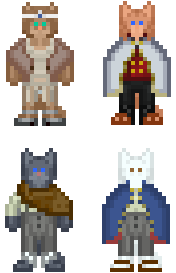 |
| Home System: S'rand'marr |
| Homeworld: Adhomai |
| Language(s): Siik'maas, Siik'Tajr, Nal'rasan, Ya'ssa, Delvahhi |
| Political Entitie(s): People's Republic of Adhomai,
Democratic People's Republic of Adhomai, New Kingdom of Adhomai |
Overview
The Tajara (direct plural: Tajara – Tah-jaw-rah both singular and multiple) (adjective: Tajaran - Tah-jaw-ran) are a race of humanoids that possess markedly felinoid traits that include a semi-prehensile tail, a body covered in fur of varying shades, and padded, digitigrade feet. Tajaran history and society is deeply entrenched in the conflict between its caste system and ruling governments. The species currently finds itself involved in a cold war between the three powers that control its homeworld, Adhomai.
To play as Tajara, apply here.
Heads of Staff
Since the end of the First Revolution, Tajara have proven themselves to be capable workers to the megacorporations of the galaxy. In the years since, some of these Tajara demonstrated competent leadership and were hired into various command positions in their company of choice. To be a Tajaran head of staff in a human- and skrell-dominated space is to have dozens of eyes on you at once. Oftentimes, these Tajara face heavier criticism, are given lower wages and fewer benefits, and still face discrimination from their peers. Severe pressure is put onto them to meet a degree of excellence higher than what would be expected for a human. The vast majority of Tajaran heads of staff, especially within NanoTrasen, remain PRA citizens. Due to their close ties to NT and being of higher diplomatic standing, megacorporations prefer to promote Republican citizens over their counterparts. The NKA opening their doors to interested companies following the armistice has made it easier for their supporters to be promoted or re-promoted; however, these types are rare. The NKA’s technological backwardness is viewed as a major detriment for leadership roles and is a given reason for why a citizen would be passed over. The DPRA’s citizens, unsurprisingly, are incredibly unpopular for a promotion choice. The nation’s xenophobic and anti-corporate attitude is well known to megacorporations, so any citizen of the DPRA who manages to become promoted is subject to yearly interviews and background checks. Any sign of a connection to radical elements means a demotion, if not a firing.
To date, there is yet to be any Tajara in a meaningful place of power within a megacorporation.
Hharar and Njarir’Akhran can be the following Heads of Staff:
- Head of Security
- Chief Medical Officer
- Executive Officer
- Research Director
- Chief Engineer
- Operations Manager
- Consular Officer
- Corporate Liason
M'sai can be the following Heads of Staff:
- Head of Security
Mechanics
- Tajara can speak a number of unique languages, such as:
- - Siik'Maas. Use this in-game by typing say ,j
- - Siik'Tajr. Use this in-game by typing say ,w
- - Ya'ssa. Use this in-game by typing say ,r
- - Nal'rasan. Only available to M'sai Tajara, use this in-game by typing say ,i
- - Delvahhi. Only available to Zhan-Khazan Tajara, use this in-game by typing say ,n
- All Tajara have claws and scratch with them instead of punching, dealing extra damage.
- Tajara are faster but take extra brute damage.
- Tajara can see much better in the dark than humans. This is possible by using a verb in-game, but that makes them vulnerable to flashes.
- Tajara are less vulnerable to harm from the cold due to their fur but more vulnerable to harm from heat.
- Tajara cannot use human gloves or shoes due to their claws and digitigrade limbs. They are only able to wear voidsuits and voidsuits helmets designed/modified for their Tajaran anatomy. They are able to wear 'softsuits' (such as regular space suits, biosuits, and fire suits).
- Tajara have a higher nutrition and hydration threshold and process reagents slightly slower.
- Tajara have a set of organs adapted to the life on Adhomai, with some differences in regard to function and form.
- Due to a long history of combined selective breeding and cultural factors, different Tajaran races have different physical qualities and attributes as well as levels of education. Visit the physiology sections of the Tajaran Ethnicities page for information about their differences.
Biology
To the average human, the Tajara share many similarities with Earth's felines; however, when looked at from a purely scientific perspective, this description is largely superficial. Unlike terrestrial felines, the Tajara are both omnivorous and bipedal. Their bodies are almost entirely covered in a thick coat of fur that is extremely good at insulating them from the extreme cold of Adhomai. The layer of body fat and fur is designed to trap body heat efficiently. There are only a handful of areas where fur is not present, those being on the palm of their hands, the soles of their feet, and a number of various orifices as well as a small area around their eyes. Tajara have nictitating membranes, a transparent eyelid layer that assists in preventing snow blindness and keeping their eyes moist against the wind.
Occasionally, the fur around a Tajara's neck is known to grow into a shaggy 'mane' of sorts, giving them a distinct look, not unlike a terran lion. This hair tends to be much stronger and a great deal wirier than the rest of the fur on a Tajara's body. Some Tajara tend towards monochromatic bodies while others have multicolor or even calico fur patterns. These designs depend heavily on the genetics of the individual's parents, much like hair and eye color. Because of this, some parents are utterly incapable of producing multicolor children. Designs including flat colors, stripes, spots, and most conceivable combinations have been recorded by scientists both Tajaran and human. A male Tajara is somewhere between 150 cm and 185 cm in height, while the mean body mass is between 65 kg and 100 kg. Females tend to range between 150 cm and 175 cm in height, with their own weight somewhere around 45 kg to 85kg. As such, both their body weight and height are roughly comparable to the average human. Height depends on a Tajara's ethnicity. Njarir'akhran were bred to be taller, M'sai are a more middle height, Hharar are typically shorter or of middle height, and Zhan-Khazan are usually the tallest of the races. Any Tajara who falls out of this range is unusually tall or short which typically stems from a medical condition. A Tajaran fetus only takes six months to mature, and Tajaran children likewise mature rapidly, reaching the full extent of their growth by 15 or 16. This rapid maturation has a profound effect on the lifespan of Tajara, as only with modern medicine have Tajara reached ages above 70, with the oldest living Tajara being 84 years old. Most Tajara retire at age 60 when they are too old to work in any capacity.
Ethnicities
There are four races of Tajara: the Hharar, the Zhan-Khazan, the Njarir’Akhran, and the M'sai. Each race has a common role that they play in a society to which their biological inclinations make them more suited, as well as their own cultures which have formed from long histories of performing these roles in society. Tajara heavily stereotype each other based on race which is often a cause for conflict. As a result of these differences, there is a lot of racial tension between these various types of Tajara which was further exacerbated by differences in socioeconomic classes.
Hharar: the first Tajaran ethnicity that Humanity came in contact with is generally viewed as the 'typical Tajara', which is reinforced by their numerical superiority over the other groups. Additionally, given their large numbers and capabilities, they most often serve in governmental positions and as ambassadors to other races; this leads to them being taken as the 'face' of the Tajaran race, as it were. Hharar trend towards being the most intellectual of all Tajaran groups, and as such their physical prowess is significantly reduced. The Hharar are the stereotypical 'worker' Tajara, commonly described as loyal employees who are passionate and not afraid to voice their opinions.
Zhan-Khazan: the second most populous of Tajaran ethnicities, and are considered to be the backbone of the Tajaran workforce. Because of their history of hard work and the way they adapted to harsh mountain life, Zhan-Khazan are more physically intimidating than other Tajara. Featuring more toned, muscular bodies, thicker fur coats, and heavier body weight, they are well-suited to tasks requiring brute strength and heavy lifting. Due to their status as laborer they suffer discrimination and are usually regarded as less intelligent.
M'sai: the third most populous Tajaran ethnic group, the M'sai were at one point the hunters for ancient Tajara and evolved to have lithe, slender forms, and light fur that hid them in the blizzards on Adhomai. As Tajaran society advanced, M'sai could be found in many roles related to combat, including law enforcement and military service. They are very loyal to their friends and family but aren't as overt about it as the Zhan-Khazan. With wide eyes and acute senses, they make great soldiers, with a vision adapted to compensate for the heavy blizzards that plague their home planet. They are also great survivalists and are capable of scrounging food for themselves via hunting.
Njarir’Akhran: the ethnic group that made up the majority of the plutocracy before the Great War. Their lineage can be traced from careful breeding between Hharar and M'sai, leading to where they currently are today. Following recent events on Adhomai, Njarir make up less than ten percent of the population. Easily identifiable by their large ears, fluffy tails, luxurious fur, and slender, elegant features. Njarir suffer persecution and rejection from certain proponents of Tajaran society because of their bloodline. As the most learned of all Tajaran ethnic groups, they boast high intelligence and have a propensity towards the arts and sciences.
For information about the ethnicities, their traits, and their cultures: see Tajaran Ethnicities
Coloration
Fur color is the most noticeable aspect of a Tajara. It acts as a natural camouflage and is the most visible difference between the ethnicities. Ancient history saw these fur colors appear in certain regions of Adhomai, however over millennia of migration, marriage, and modern travel, every coloration of fur can be seen across Adhomai and now the Spur.
These fur colors are suggestions and guidelines. Any one Tajara could have a variation of the colors shown, whether it be lighter or darker.
Hharar:
Hharar fur coloration traces back to the proto-Hharar peoples of Southern Ras'nrr. The forests between the Rhazar and Khazan mountains alongside the fertile soil allowed for the invention of farming, and later the formation of Adhomai’s first civilizations. The Hharar people evolved to feature brown fur colorations due to the numerous woods they lived in.
Zhan-Khazan:
Zhan fur colorations are the result of a long history of mountain tribes. Even during winter seasons, the darker fur colorations permitted better camouflage with the rocky terrain of the Ras’nrr mountains.
Njarir'Akhran:
Njarir fur colorations are the results of the extensive eugenics programs employed by the Adhomian nobilities. Through decades of careful merging of M’sai and Hharar bloodlines, along with high amounts of inbreeding, Njarir now feature the flashiest fur colors among Tajara. Despite the inherent nature of genetics, reputations for different fur colorations have taken root among noble circles even following the revolutions.
M'sai:
M’sai fur is the result of the behaviors of proto-M’sai. Having been a nomadic people of the open prairies in Ras’nrr, the light fur color was often the only way Tajaran hunters were capable of hiding or blending into the environment.
Tajaran Evolution
The Tajara evolved as a predatory species upon their home planet of Adhomai, and as a result, they have a pair of fairly large, well-developed eyes that are forward set. These eyes are comparable to those of humans, but they are more effective in low-light situations due to the Tajaran ancestors having to hunt in dark cave tunnels. Tajaran eyes are set above a slightly elongated structure comprised of hard bone similar to a muzzle on terrestrial creatures. Their pupils are large and capable of contracting significantly faster than most other creatures, both sapient and otherwise. This allows for a considerable degree of low light vision, however, they have a thin reflective layer that has the side-effect of appearing illuminated in the dark.
The Tajaran dental structure was at one point in their evolutionary history once geared for a carnivorous lifestyle but has since evolved and shifted towards a more omnivorous role. Tajara have sharp, needle-like teeth in the front of their jaw which is quite clearly geared to tear meat; the further along the jawline one goes, teeth similar to human molars reside behind the sharp canines, evidence of the change to an omnivorous diet. Evolutionary biologists believe that predecessors to modern Tajara had rough tongues with few taste buds to facilitate eating raw meat. The contemporary species has evolved out of this a long time ago in conjunction with becoming omnivorous, and so they now have softer tongues with a full sense of taste. Atop their heads, Tajara have a pair of deft, normally erect ears that are capable of a wide range of motion. They can rotate to roughly ninety degrees, capable of even being able to fold back almost entirely onto the skull if needed.
Extremities and Sleep Cycle
Tajaran extremities, specifically their hands and feet have five digits and are generally the same shape as human extremities. However, they are slightly stubbier in appearance, though still dexterous enough to be useful. Tajara employed in more professional roles such as engineers, architects, or other occupations that require dexterous manipulation often find themselves with filed down claws, reduced to a smooth end to allow easy usage of standard human-based technology. This is a task that Tajara tend to do reluctantly, given that cutting too short is incredibly painful and will expose nerves to the air. Normally, these claws are non-retractable and grow from the fingertips, usually measuring around 1-2 centimeters.
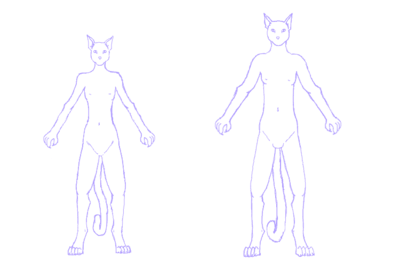
The sleep cycles of the Tajaran species are one of their most scientifically curious features. A normal waking period is somewhere between thirty-six and forty-eight hours, with a subsequent twenty to twenty-eight hours of sleep. Normally, the waking period is spotted with three to four fifteen-minute naps to keep the Tajara refreshed and alert. This is universal in all worlds with Tajaran living upon them. Tajara are capable of great feats of intelligent, dedicated work but this is physically exhausting, which renders them utterly mentally and psychologically exhausted. Those that do not enter their sleep cycle properly may find themselves groggy, aggressive, paranoid, and disoriented until their circadian rhythm is righted.
Tajaran Build
Compared to most other known species, the Tajaran body is designed to be more flexible, lithe, and slender despite its thick insulation. A handful of Tajaran ethnicities do not exhibit these traits and instead manifest increased muscle size, strength, or bulk. Tajara are sexually dimorphic; females have more elongated muzzles, shorter ears, and more petite forms. Their distribution of body fat is entirely different from that of a male. Females do not exhibit visible breasts until pregnancy, at which point they swell in order to provide for the young. Males are in general taller, have broader shoulders, bigger hands and feet, and more pointed ears.
Tajara are built for extremely low-temperature environments that are incredibly common on Adhomai, giving them remarkable cold resistance. However, this gives them a tendency to overheat in more mild environments. To avoid this, most Tajara dress lightly in warmer environments such as those on human installations or tropical worlds. Forgoing the usual layer-like clothing, these Tajara resign themselves to thin clothing. Those who find themselves confined to bio-suit or radiation suit for extended periods of time end up feeling extremely uncomfortable.
History
Nobility and the Ancient Past
For as long as Tajara care to remember, Adhomai had always been under the rule of the nobility. The oldest historical text that exists in Tajaran possession dates back at least three thousand years and talks about the presence of nobles. Many historians agree that the trend of blood rule is more deeply-rooted in Tajaran existence than was before considered.
The ancient past of the Tajara is poorly documented and historical texts are rare; meticulous combing and destruction of educational material by millennia of harsh rule resulted in the total atrophy of most scientific arts in Tajaran society. Little is known about Tajara civilization before 1500 BCE Galactic Standard Time.
The earliest form of government were local monarchies supported by religious authorities; the ruler and their families were considered of divine origin. Most of the settlements were similar to rural fiefs, with the population working for those dynasties in trade of their protection. Urban centers started to appear around places of worship. Peasants had little to no rights, and all dissidence was met harshly and fatally at the hands of the Nobles' Enforcers - trained agents (commonly of M'sai descent) who fought for the nobility of Adhomai in exchange for relative freedom. These Tajaran enforcers kept the peasants of Adhomai's lands repressed and powerless through shock and terror.
What is known for sure, however, is that tension and violence had slowly been increasing over hundreds of years between the populace and their fellow noble families.
Tensions Rise
Tajara historians believe that global violence spilled out across the planet between the kingdoms and the other scattered noble families in 80 CE. Those states clashed and either pitted their followers against one another. The noble leaders continued to fight and inter-marry until the ruling families had become exclusively Njarir’Akhran. Over time, the nobility slowly began to lose their religious inclination, adopting more traditional civil institutions and a relaxation of the church's control which gave way to state control. Religious worship of the noble families had been dropping steadily in conjunction with their lower influence on the other nobility. It was during this period that historians believe the overwhelming control of the noble families flourished and solidified into what it was prior to human contact.
Even with technological and governmental advances, the Adhomian society was stuck with its old feudal system. The tension between the nobility and the peasantry increased due to new burdens brought by military campaigns. The first writings against the serfdom and caste systems started to appear around 1732 CE, with those early revolutionaries being dealt with violence by M’sai enforcers. Draconian laws and sanctions were introduced against those that defied the status quo. Relations between the ruling class and commoners were precarious, believed to have stemmed from harsh rulers and laws. Technological and cultural knowledge and breakthroughs had begun to trickle down from the noble families to the peasantry. The invention of the printing press in 1756 CE favored the spread of anti-monarchist pamphlets. Owning a copy of an unapproved text was a capital crime.
Adhomai underwent a form of industrialization with the creation and proliferation of the steam engine in 1954 CE. However, this only forced the Adhomai peasants into harsh new labor digging in mines and working 18-hour days building rail lines for private use by the Njarir’Akhran nobility. Laws were soon enacted that banned any non-Njarir’Akhran from utilizing electricity or riding on trains. This trend of nobles hoarding new technology or innovations at the expense of the peasants continued until human contact.
Thirty years prior to the human discovery of Adhomai, the deep-seated mistrust between peasants and nobles had reached an all-time high. The Tajaran species was trapped in a technological bubble forced upon them by their nobility. At the height of their industrial revolution only a few years prior, the leadership at the time became increasingly wary of the unification of many Tajaran workers who demanded greater rights. The realms of education, science, and luxury found themselves under severe restrictions, and your basic Tajara was forced into almost twenty-hour workdays with minimal time afforded for eating and sleeping on the job. Analysis of the noble houses proves that during this time in Tajaran history, the nobility had never been worth more in Sol credits than previously. This is largely attributed to the fact that rather than modernizing Adhomai the nobility had seen fit to confiscate and use these fruits of scientific thinking for themselves.
Automobiles are considered one of the best examples of this. The first automobile is recorded to have been created in 2292 CE. Using a combustion engine much like primitive human vehicles, with extra anti-freezing measures and thick treads, one of the first fully functional automated cars had been produced by a collection of Tajaran engineers and scientists, at the behest of the nobility. Older Tajara considered these large creations to be a symbol of negligence and gluttony by their leaders. Workers were never provided with such things; they were forced to transport themselves through Adhomai's harsh winter conditions on foot or by using specially designed 'snow bicycles', regardless of how far away their place of work was.
Further restricting the rights of the individual Tajara was enacted by a furious nobility after several instances of violence against Njarir’Akhran, but specific information on these incidents has been lost. Legislations were introduced against 'workers unions' as well as any sort of illicit groups; a permit was required to form anything from hunting parties to agencies. In this whirlwind of political turmoil, a fresh generation of Tajara were growing up, deprived of what most humans consider to be basic rights. As they grew older and angrier, the nobility saw fit to continue tightening their control over their subjects until a civil war was almost inevitable. Like a powder keg ready to blow, only a single spark was needed to light the flame.
Human Discovery
This came in the form of human discovery in 2418 CE. A Sol Alliance funded expedition into the Tajaran home system discovered the pre-space age species and their homeworld of Adhomai. Lush with untapped resources and potential workers, Adhomai was an attractive prospect for many human super corporations, especially NanoTrasen. Because of their slow technological progress, most of Adhomai's valuable minerals remained untapped by mining or drilling. Because of this, several megacorporations attempted to insert themselves into the dealings of Adhomai.
However, the nobility felt incredibly threatened by what they considered 'intrusions' by humanity and completely refused them diplomatic access to their planet. The Alliance stepped in, initially unwilling to interfere in a pre-space age society and, reluctantly, the super corporations were forced to abandon their wishes to stake claims on Adhomai's resources - at least in the open. In the year 2420 CE, a group of Tajaran intellectuals - considered rebels by the state - were shuttled off-world by a still unknown entity. Given asylum in the Sol Alliance, they met and discussed much with human scientists and officials. Tensions between the Alliance and Tajaran nobility rose after such an event and they accused the humans of harboring terrorists.
Eventually, these rebels were returned to Adhomai with supplies and weapons. Fed with new ideals of personal freedom and 'rights afforded to all' by their influential human friends, the seeds of revolution were sowed among the Tajaran populace, spread by word of mouth. Workers, doctors, teachers, and even soldiers who were questionably loyal to the nobility were swayed by these promises of freedom and equality. Meetings in the basements of dark taverns or barns were common, and relations between the nobility and their peasants were at the lowest ever recorded in Tajaran history.
The Uprisings
It took little more than a year for a formal uprising to be staged. In 2421 CE, after the nobility had captured one of the original Tajara that had been shuttled off-world, he was sentenced to be publicly hanged by the neck in front of their peasants to show just how serious they were about keeping control. Ultimately, many historians believe this to be a highly egregious mistake. Rebels in the audience, armed with advanced off-world weapons, proceeded to open fire on loyalist forces and kill a nobleman in the process. This event, called the D'as'ral Massacre (so named for the city it took place in) by the nobility was all the excuse they needed to enact martial law.

However, they found themselves in a cornered position. Weapons and supplies were being shipped off-world by mysterious benefactors, and their collections of scientists and engineers had either fled to safety being noblemen themselves or took up arms and joined the revolution. Without significant scientific presence to deconstruct or understand these new human weapons or support the war effort, the conflict resulted in a string of rebel victories drawing closer and closer to the capital cities of each kingdom. Fighting was extremely fierce and atrocities were recorded by both sides.
Among the noble families, the largest and nearly the most powerful was a dynasty called the 'Hadii'. Their castle was amongst the best defended in the region and the battle to take it was waged for six months of non-stop fighting. As it became increasingly clear to them that they were eventually going to be overrun, the Hadii struck a deal with the rebel leader; in return for complete immunity from the war, as well as persecution, they afforded the revolutionaries with unique tools and even blueprints of other families' castles, pointing out weak points and infiltration spots.
This turn coating tipped the revolution in favor of the rebels. Armed with this new information, they made use of radio systems previously restricted to nobility to methodically and ruthlessly end their uprising by murdering most of the noble families, and whatever soldiers and civilians remained loyal to them. By 2431 CE the revolution had finally come to an end with a total of more than 92 million casualties with more than half being loyalist forces and 40 million civilian deaths. Many Tajaran cities and villages were utterly destroyed by vicious fighting as well as bombardment by uncaring nobles. An informal ceasefire was declared between the factions, though skirmishes were still common.
Outcome of the Revolution
Following the First Revolution, the Hadii emerged as the victorious faction. They had annexed, through diplomacy or war, the remaining factions. Human corporations took an express interest in the Hadii dynasty; they were one of the few noble families who saw profit in human stakes on Adhomai, and many back-room deals were made to secure the Hadii's position in the new Government. In 2432 CE, the People's Republic of Adhomai was officially declared, with Al'mari Hadii, also known as Rhagrrhuzau Hadii, as its leader. The Tajaran public was markedly distressed by this turn of events, and fearing another uprising, human intervention again helped defuse the situation. The Hadii promised that it would not be like it was before.
NanoTrasen, suspected by many conspiracy theorists to be behind the funding and supplying of Tajara during the war, had a monopoly over the majority of the planet's valuables. Collaboration between the People's Republic, the Sol Alliance, and the Nralakk Federation have resulted in more technological advances in Tajaran society recently than ever before in their recorded history. The People's Republic began campaigns to quickly industrialize Adhomai and educate its people. Approval ratings for the current leadership rose in response.
However, serious problems remained. Al'mari Hadii suddenly began to back out of the People's Republic's agreed-upon business deals with NanoTrasen, all of which saw a massive amount of Tajaran natural resources exported. Citing humanity as greedy and destructive, Al'mari made clear his intentions to make Adhomai independent until it was ready to take on the burden of interstellar politics.
The Second Revolution
The disagreements and hatred of the Hadii republican government had led to insurrection and treachery among Adhomai's major power figures since Al'mari's new economic policies were revealed. Many Tajaran business contractors - just recently denied their ability to sell ludicrous amounts of natural resources and workers to the massive human megacorporation, NanoTrasen - felt threatened by the reforms of the Hadii government and its first President, Al'mari Hadii. In 2451 CE, during a military parade, President Al'mari was assassinated by Tufir Nazzirai. A known secret service agent of the People's Republic, the radical was swiftly sentenced to death for his betrayal, which claimed to be brought on by the violent tendencies of his Zhan-Khazan genetics. His brother and vice-president Njadrasanukii Hadii, also known as Malik Hadii, quickly assumed the office of the presidency and immediately passed brutal laws that punished the Zhan-Khazan and subversive elements. NanoTrasen was invited back to Adhomai and menial workers were sold en masse to NanoTrasen workplaces while the rights to the bountiful natural resources of Adhomai were sold off to NanoTrasen. Public hangings and firing squads became the norm once again.
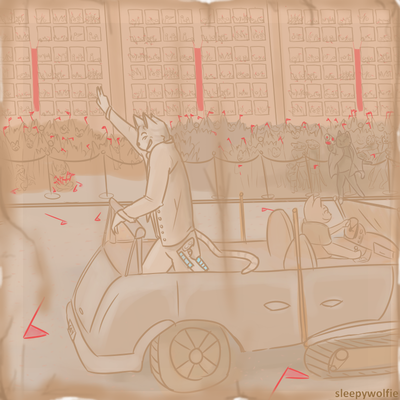
While Al'mari implemented his new policies, the People's Republic saw the return of a surviving dynasty, the Azunja, in the form of an uprising in its most remote region. This faction, the New Kingdom of Adhomai, attempted to bring back monarchism to Adhomai through a constitutional monarchy.
Many military generals who had fought for the Republic soon defected under the banner of the Adhomai Liberation Army, the leader of which being Al'mari's old friend and ally, Halkiikijr Nated'Hakhan, who claimed that he wanted to take control of the People's Republic to finally out Al'mari's legacy. "His gun was on stun" became the rallying cry of Nated's fiercest supporters as they alluded to how he not only left himself greatly vulnerable during the parade but had even left his energy pistol on stun while he was assassinated.
With these two rebellions, Adhomai found itself embroiled in yet another global conflict.
Adhomai Today
The Tajaran home world has suffered plenty in the three decades since the end of the First Revolution. With the sudden injection of advanced technology into their relatively simple life, the discrepancy between modernized cities and outlying areas could not be more obvious. While the Tajaran capital boasts the most modern developments with sleek skyscrapers, advanced connections, and phone lines, as well as hospitals and schools, the further you get from the larger cities, the more apparent it is that things are not quite so flashy. Expanding infrastructure remains difficult, as most public funds are seized for use by the military or used to repair infrastructure damaged by shelling or bombings.
There is a steady stream of money being fed into the People's Republic of Adhomai. NanoTrasen, as per its agreement with the president, has set up mining and logging operations on Adhomai using the local workforce for the most menial of tasks. In return, company-funded clinics and schools are slowly being spread out and built-in needy areas.
Literacy has risen to its all-time high on Adhomai, and with the assistance of the Alliance, teachers have been brought in from off-world to educate the younger generation of Tajara. However, this number has begun to decline as the dangers of working on Adhomai are beginning to become common knowledge. Special establishments for older students have also been constructed to assist the elder generation into being brought to the same level of education, but NanoTrasen has not expressed significant interest in this; these people make up the brunt of their low-paid workforce and they want to ensure they are kept this way.
The second revolution came to an end in 2461, after a decade of warfare between the three factions. The People's Republic of Adhomai was driven off from many of its past territories, having to rely on the help of a coalition of allied states and mercenaries to stop the enemy offensive. After months of bloody defenses, guerrillas attacks, and complete stagnation of all fronts, a ceasefire was signed with the support of Tau Ceti and Nralakk. An armistice, known as the Armistice of Shastar, was signed by the three factions shortly after. With the recognition of the Democratic People's Republic of Adhomai and the New Kingdom of Adhomai by the galactic community and the enforced peace, the three Tajaran powers are eager to compete with each other for supremacy through a cold war.
One of the clauses of the Armistice of Shastar was the creation of the Tajaran Citizenship Act; a legal provision allowing DPRA and NKA citizens to legalize their citizenship situation, forfeiting their previous PRA affiliation. Tajara living outside of S'rand'marr were able to request the transfer through the proper diplomatic services. Following rising tensions and incidents between the Adhomian factions, this agreement came to an end in 2462.
The Tajara species is now undergoing a cold war between the three factions. This period is marked by nuclear arms races, proxy conflicts, and subterfuge.
More information: Tajaran History
Tajaran Factions
Adhomai is controlled by three factions, who once participated in a civil war for the control of the planet and are now engaged in a cold war.
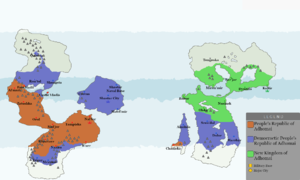
Led by President Njadrasanukii Hadii, the People's Republic of Adhomai is the global state that emerged from the First Revolution. Before the Second Civil war, it enjoyed galactic recognition as the sole government of Adhomai. It claims to be the true keeper of Al'mari’s legacy. However, the PRA can be described as a Hadiist branch of Al’mari’s revolutionary ideology - that means putting the State at the top of a hierarchy of power. The PRA is a very centralized state, but in recent years has slowly been able to start making true its promises to bring revolution to the masses. With land reform, the enfranchisement of women and peasantry, literacy initiatives, and the collectivization of farms and the means of production, the PRA is struggling to hold true to its radical ideals while an entrenched upper party stubbornly tries to hold onto power.
The Hadiist rule is marked by a lack of privacy, enthusiastic police, and pervasive secret police that leave privacy a nebulous concept to most Tajara. During the height of the war, anyone suspected of supporting traitors or publicizing media critical of the Hadii faced harsh retribution, but these practices are becoming less pervasive as wartime zealotry fades. Life under the government, while not free, is often stable and safe. Under the Republic, Tajara have more opportunities than they have had historically, with the Party investing heavily in its people. NanoTrasen continues to throw out large nets and bring in hundreds or even thousands of Tajara new employment opportunities in the galaxy as well as selling designs for ships and other space-faring aircraft to the People's Republic's Military. NanoTrasen is also accused of being very exploitative of Tajara laborers, but for many Tajara the company is their path to the adventure of the wider galaxy.
After the Second Revolution, the People's Republic lost its hegemony over Adhomai. The Hadiist state is now focused on preparing itself for a future reunification war. Large public works, research efforts, and military expansions are underway. As President Hadii grows old, the power struggle between his possible successors intensifies. Each possible heir now works to build their own support base without openly challenging the President or attracting too much attention to their plans.
 Adhomai Liberation Army | Democratic People's Republic of Adhomai
Adhomai Liberation Army | Democratic People's Republic of Adhomai
The most pervasive and successful rebellion came from a group called the Adhomai Liberation Army, a group made up of Tajara from almost every walk of life. This organization opposed corporate claims on Tajaran soil and denounced the mismatched development and governmental negligence as the fault of humanity. During the height of the war, settlements liberated by the Liberation Army were ruled by a military junta. Being a supporter of the Hadiist government, or having been a collaborator, was grounds for immediate execution by firing squad. Villages often found their supplies seized by Liberation forces for the war effort, and the whole movement was a massive, tenacious military dictatorship under the absolute authority of Supreme Commander Halkiikijr Na'ted'Akhan.
Following the release of their updated 2459 manifesto, the various regional civilian governments formed under their rule coalesced into the Democratic People's Republic of Adhomai. Authority is still highly decentralized. In January of 2461, a contested election saw Almrah Harrlala become president Contested by the military, the so-called Nated Supremacist Movement launched a putsch that was ultimately foiled by Nated himself, who appealed for the return of civilian government and then resigned his command.
The DPRA is now led by President Almrah Harrlala who is struggling to transition what was once a militant insurgency movement into a modern, democratic nation. The government attempts to negotiate with ruling Juntas to voluntarily turn over power to the civilian administration, many of which still refuse. The DPRA does, for the most part, try to respect the basic rights of Tajara. Most Tajara under civilian rule do not need to worry about the secret police or being framed for a crime of civil disobedience. With the Armistice, the DPRA gained intergalactic recognition as one of the Tajaran states. In more recent times, DPRA citizens are being sponsored by Harrlala's government to go out into the galaxy openly and show what Tajara can achieve on their own terms without being puppets of human megacorporations. As President Harrlala's term comes close to its end and the next election is being organized, the fragile Al'mariist democracy is threatened by all kinds of extremists.
The last major faction is the rebellious New Kingdom of Adhomai, which seceded and declared itself a nation in 2450. The New Kingdom is ruled by a Njarir'Akhran noble line that survived the First Revolution by hiding, owing to the efforts of their supporters. Founded by King Vahzirthaamro Azunja specifically, he denounced both other factions in the civil war as illegitimate and himself as the only rightful ruler of Adhomai. Supporters of the New Kingdom tend to be rare outside lands it controls. However, they believe strongly that the People's Republic was founded on genocide and unspeakable slaughters. The only way to return Adhomai to peace and prosperity is to learn from the mistakes of the ancient nobles and revolutionaries; a constitutional monarchy is necessary to prevent abuses of power.
During the war, the New Kingdom faced shortages of all kinds of goods. Both commoners and nobles were stuck in crippling debt and poverty. The support for the war quickly diminished as the conflict dragged on. While the New Kingdom was able to reconquer its original lands and other territories, it failed to defeat the PRA and DPRA. The final years of King Azunja's rule were marked by political turmoil as the people requested further political recognition.
Queen Shumaila Azunja rose to power after King Azunja died in 2463. She now faces a Kingdom in turmoil due to the changes brought by the Cold War. The economy prospers due to the end of the embargo and the presence of megacorporations. The income inequality between the nobles and commoners grows. Dissent movements also begin to appear as the people become more disillusioned with the Kingdom's realities. In the Parliament, infighting ensues as each faction tries to influence the Queen. The future for the NKA remains uncertain.
Social
Names
Native Tajaran names have changed over the storied history of the species. The earliest record of naming conventions appears in the Warring Kings era, where the usage of dynastic titles became a standard part of the Tajaran name as a way to distinguish which noble a given serf worked under. Since then, names changed as more titles were attached. Jobs, personality traits, status, titles, age, given names, and more have been combined to produce the infamously long and unwieldy names associated with history. Following the declaration of the Steeple Peace, nobles across Adhomai standardized to a new scheme which continues to persist among the Tajaran people.
Every name features three aspects: The individual, the dynasty, and the purpose. Xeno-linguists associate these aspects to the human concepts of the given name, the family name, and the job title respectively. This has resulted in debate over forced associations, as each aspect has a different connotation than what humans may expect, namely the Dynasty. Unlike humans, family names are only found with noble dynasties. This has led to many xeno organizations to assume that Tajara associate with large extended families.
The Individual aspect is the personal part of a Tajara’s name. Parents will provide their child with the Individual aspect in hopes that the phrase or word used will become a part of the Tajara's person. It is not uncommon for Tajara to bear the names of gods or powerful figures, or for others to be named after abstract, religious, or ideological concepts. The Dynasty aspect is the standardized part of a Tajara’s name. Following the First Revolution, the Hadiist government mandated the Dynasty aspect be named after the birthplace of an individual as a means to remove the influences of the nobility. Those stubborn Tajara born before the end of the First Revolution, or those now living in the New Kingdom, often refused to change their Dynasty aspect, continuing to reflect the noble family they serve or are a part of.
The Purpose aspect previously was the utilitarian part of a Tajara’s name. The aspect reflected a job or trade, an essential piece of information within a community. However, since the end of the first revolution, the need for static names to lessen the bureaucratic burden resulted in many Purpose aspects turning into a form of family name, a newer and still contentious concept for Tajara. With the number of regional dialects and multiple titles for the same trade or job, Purpose aspects are rarely the same across Adhomai. In some cases, two families joining together in marriage would combine their two aspects to form a new one.
While a Tajara’s name contains all three aspects, the usage of all three is not required. Most Tajara will utilize the Individual and Purpose aspect, however traditionalists and nobility expect the use of the Dynasty aspect. All Tajara on the Horizon may use only two aspects.
The following guide is not required. Native names can vary based on parentage, region, and numerous other factors. This guide is a structured option, however other options include taking inspiration from the Notable Tajara page, and heavily modifying Eastern European or Arabic names.
To create a native Tajaran name, you will need to access the unofficial translator here. Select Siik’maas under the language drop down. By typing in certain words or phrases, then translating, you can utilize Tajaran words to create a name. Typically, you will want to connect multiple Tajaran words with an apostrophe or hyphen, however combining two words without a space is acceptable.
- For the Individual aspect, use a phrase, trait, or concept.
- For example: Love becomes Azutul. S'rendarr's Warmth (Kirmah rajzir. Zir) becomes Kirmah’rajzir.
- For the Dynasty aspect, you may use any text you prefer. Regions and cities with royalty or dynasty attached usually garners better results. Hadiists typically utilize the name of the city or region they were born.
- For example: Kaltir Royalty (Jurlket mir mrra) becomes Jurlket’mir. Nal’tor (Jri chur) becomes Jri’chur
- For the Purpose aspect, use the title of the job or craft of the Tajara. Use multiple versions of a given job or trade for better results.
- For example: Police Officer (Kaii'r manq rir) becomes Kaii’rirmanq. Prince becomes Vahkal.
- The final name becomes: Azutul Jurlket’mir Kaii’rirmanq.
- From this, you can tell the individual is Azutul or named love, whose liege is the Jurlket’mir or Kaltir Royalty, and performs work as a Kaii’rirmanq or officer.
The translator output rarely gives a word or name ready for use. Modification will be required as seen in the examples provided. This also means that names cannot be decoded.
Xeno-Influenced Names
Given native tajaran names are difficult for humans to pronounce, the PRA once encouraged the use of humanized names. This resulted in many Tajara taking on names derived from Eastern European or Arabic origin, as xeno-linguists found these the easiest for Tajara to pronounce. Following the transition of power from Al’marii to President Hadii, the PRA has walked back on this stance and since issued a decree to encourage citizens retake their native names as a form of pride in tradition and loyalty to the party. Many Hadiists have heeded this decree and returned to their native names, however a sizable population continues to use their adopted names. Given Tajara may have multiple names, the Adhomian governments are more dedicated in the tracking of names.
Language
As with all other species who work in Human-centric environments. Tajara are expected and required to have passed a prerequisite test to test their comprehension of Tau-Ceti basic, the operating language of NanoTrasen and most transstellar corporations, in addition to most major sovereign entities. Admittedly the passing levels of these comprehension tests are quite low, but are high enough to ensure basic conversation between what will likely be a multi-species crew. However, private communication in Tajaran languages such as Siik’Maas or Siik’tajr is not forbidden by SCC regulations and is often used to hold conversations between Tajara on the crew.
Though there are a variety of languages used by the Tajara, among the foremost of this vast plethora of languages are Siik'mas and Siik'tajr.
Siik'maas is theorized to have been the ancient language of the Tajara, the 'religious' tongue shared between most Tajara from their onset as a species. Despite Tajaran society evolving to a point where religious devotion became less encouraged, the universal service language used in all churches and worship sessions became the lingua franca and almost every Tajara knows how to speak it. It has been taught as the primary educational language amongst most Tajaran ethnicities since the Migration Age and continues to be the most prevalent tongue on Adhomai since.
It is capable of being spoken by a learned human, as it is not as reliant on body language as Siik'tajr or the other native languages on Adhomai. However, just as Tau Ceti basic is difficult for Tajara to master given their muzzle structure, Siik'maas is the same to humans, since they lack the proper biology to perform certain inflections properly. Despite focusing more on the spoken word than others, some of the vocabularies require subtle body movements that are challenging for humans to grasp, no less perform. Even if one were to learn these movements, they tend to be sluggish and slower, giving the speech a sort of 'drunken' feeling. Tajara speaking this over the radio often find themselves in similar positions. Siik'maas is the federal language of the People's Republic of Adhomai. However, several groups of Tajara ranging from scholars to traditional followers of the old ways are attempting to revive older languages such as Nal'rasan, Delvahhi, Ya'ssa, and other such languages.
Siik’tajr is the opposite of Siik’mas completely. A recent construction, it has seen more use recently following the overthrowing of the plutocracy. It was birthed from the necessity for a language that was difficult for law enforcers to understand, enabling revolutionaries to converse privately without having their conversations monitored or overheard. Revolutionary radicals have been a part of Adhomai's history for a long while, but were always small; however, when the Great War broke out, Siik'tajr saw widespread use by rebel forces during military operations. It is a combination of Siik'mas and the more body language inclined Nal'rasan, a tongue traditionally used by hunters. It is not normally used in daily life due to its complexity, it is often maintained as a secondary language, especially for families who fought in the Great War.
Pro-human groups within Tajaran society have repeatedly attempted to push Cyrillic or Latin alphabets as 'easier to use' rather than the native Tajaran alphabet. However, the vast majority of Tajara use the old Siik alphabet and it is the federally enforced alphabet taught in schools, the original alphabet learned Tajara have been using for centuries. It has undergone certain modifications since the Great War to remove the influence of the plutocracy and has made a widespread comeback with increasing literary levels among the Tajaran public.
Tajaran culture necessitates a separation of the personal self and the external self. This cultural force can be traced back to the early worship of the Twin Suns, which throughout its history has emphasized a separation of personal and public matters. This separation was later reinforced by the nobility, eventually becoming an embedded part of all Tajaran languages. The result is a grammatical structure that separates the private and public self. In Tau Ceti Basic, this has been translated into the use of first, second, and third person pronouns as the closest fit.
The public self, third-person pronouns (he/him, she/her), is the formal state. It shows respect and a distancing of one’s personal matters from others. Traditionalist Tajara would expect the use of the Dynasty aspect and appropriate titles when speaking in the public self. However, those from progressive regions rarely pay attention to the use of aspects as the weight of dynasties and the nobility is not present. Strangers meeting, a subordinate addressing a superior, and other cases where formality and respect is expected uses the public self.
"His greetings to the madam."
In this line, Person A speaks to Person B's public self through his own. As Person A does not know Person B’s name or title, madam is used to maintain respect.
“Hello Officer Smith. She is chef Al-Kandari.”
Person A addresses Person B, a human, through their title and last name. Person A maintains the public self through the use of her own title and Dynasty aspect.
The use of second-person pronouns (you/your) can depend on where someone is from. Non-traditionalist regions, such as the Hadiist lands, don’t consider second-person pronouns formal or informal. Traditional cultures, such as the New Kingdom, find second-person pronouns informal. In this latter case, it is reserved for use by a superior addressing a subordinate or similar cases.
“You need to handle that report by tomorrow. She will ensure it shows on your performance review otherwise.”
Person A addresses Person B through the personal self (you/your). It shows that Person A is either disrespectful, a superior, or from regions where the use of ‘you’ is not informal.
The personal self, first-person pronouns (I/me/mine), is the informal state. It is addressing matters on a personal level where formality is not required, or genuinity is desired. The Individual aspect can be used by itself in this state. Close friends, personal moments, and similar matters would use the personal self.
“I am unsure what you mean by this. Your proposal vexes me.”
Person A uses the personal self and addresses Person B in the personal self. This establishes a close and informal conversation or is used to disrespect Person B by addressing them directly.
Transitioning from public to personal selfs is easy. The initiator who desires to make the conversation informal starts by referring to themself in the personal self. If the other participants agree to make a conversation informal, then they respond in kind using the personal self. Otherwise, they may continue to use the public self and maintain the conversation’s formality.
"No, I simply wanted to be introduced to her. My name is Abdal Akhtarov."
Person A steps into the personal self but is still speaking to Person B through her public self. This is an invitation to personal conversation, done respectfully by not involving Person B's personal self directly.
"Hello, Mr. Akhtarov. I am Aisha. Does he wish to speak elsewhere?"
Person B is still speaking to Person A's public self, however refers to herself in the personal self, accepting the invitation to an informal conversation. In the following conversation, it would be acceptable for both to use personal self.
The use of the public and personal self by non-Tajara can be jarring for those not acclimated to human environments. Tajara not used to human space can find it disrespectful how the use of the personal self is standard. Those acclimated to non-Tajaran patterns of speech rarely take issue with the lack of distinction between public and personal self. Referring to a non-Tajara through informal pronouns is broadly acceptable, however the use of first-person pronouns, the personal self, as a default often takes years in human space and a concerted effort for a Tajara to transition to.
Emotional Displays
Because of their anatomy, Tajara express emotions in different ways than Humans. Baring one’s teeth is a strong expression of challenge or mockery. As such, Tajara rarely smile by showing the teeth, instead wrinkling the nose by gently lifting the sides of the muzzle. The folding of ears is a clear sign of fear or worry, while perking the ears forward shows attention or interest. Ears will involuntarily flick when exposed to loud sounds.
The semi-prehensile tail of Tajara allows for a great amount of expression. Enough emphasis has been placed on the tail as a form of expression and language that Tajara afflicted with Hakh’jar are commonly misread or have to vocalize their current emotion. Tajaran tails naturally sway, however a rapid sway or wag is a childish sign of satisfaction. Curving the tail downward and blistering is a clear sign of hostility, whereas tucking the tail down by the feet is a stress response. The flicking of the tail end is a sign of anger or anxiety.
Displays of affection among Tajara are rarely seen in public, and looked down on by traditionally minded Tajara. The common forms of affection are the bumping as muzzles or holding of the wrist. While less common, twining the tail around an ankle or wrist is seen as equivalent to holding the wrist. Intertwining tails, however, is seen as a childish expression of affection. Hugging is not seen romantically. It is seen as a transfer of body heat and thus a common act between friends, comrades, and family alike. Those acclimated to human expression may view hugging as having a romantic component in certain contexts, however this is lost on those with a traditional mindset.
Status was a major aspect of emotional expression during the times of the nobility. When interacting with another of a higher social status, it was required for the lesser of the two to lower their head and pull the ears back. Having direct eye-contact or tilting the head up was seen as a show of defiance. These expectations have since been challenged and are often disregarded if not outright rejected since the fall of the old nobility, however those traditional-minded Tajara and Royalists within the New Kingdom continue to abide by the rules of status.
Religion
S'rand'marr Worship
"By day and light of S'Rendarr, we live and bask in his warmth, happy and content. By the warmth and light of Messa, we cease breath and fall to death. Only by the love and harmony of both the Twin Gods and Sibling Suns do we live happily, and die the same. By the Twin Gods and Sibling Suns, S'Rendarr and Messa, the faithful ask for your blessing, and to please extend it to the non-faithful who do no wrong, and cast no sin."
- The "First Prayer" of S'rand'marr Worship
There are a handful of faiths on Adhomai, but the majority religion is the worship of S'rendarr and Messa, the names of both suns in the Tajaran home system. Ancient Tajara were believed to worship the suns as gods, believing their light to be the only thing keeping the planet from freezing over entirely. Over time, this faith matured into a system of beliefs suited to the peasantry; looking down upon the acts of betraying your fellow worker and attempting to foster unity and understanding amongst its followers. It is believed by many that S'rendarr is the god of life and the day, as the bigger of the two suns, and he is associated with good happenings and is most often prayed to. Contrastingly, Messa, the blue sun, is the goddess of the night and death; whenever she eclipses S'rendarr, all followers partake in religious rituals asking Messa to spare them from whatever ill tidings she may bring. The worship of the sun gods is dominated by an organization called the Parivara, meaning, the "Family." The head of the Parivara is Father Valyan K'rrirran who is based out of Sana Sahira, a holy city on the tallest mountain on Adhomai which roughly translates into the City of the Suns.
Sana Sahira's location in the People's Republic places the Parivara in the precarious position of having to act favorably to the faction's government, however, Father Valyan K'rrirran attempts to stay out of politics in order to avoid alienating any worshipers across borders. The Father of the Parivara is chosen by the Brothers of the Suns who serve as the priests and clergy of the faith. Devoted women of the faith can become Suns' Sisters, who take a vow of silence, like the Gods themselves, and live in the temples devoted to the worship, tending to them in any way needed, anything from cleaning to heavy manual labor repairing and replacing glass or furniture, to healing the Brothers, patrons and other Suns' Sisters. To cause harm to a Suns' Sister is said to be one of the most unholy things you can do in a place of worship, as they're meant to emulate the Gods themselves, silent, but strong and dependable.
Ma'ta'ke
The second-largest religion is the worship of the Mata'ke and his cohort companion gods, which dates back to ancient Tajaran times. A figure of legend, Mata'ke is believed to have been the head of a hardy tribe of mountain dwellers who regularly came to the aid of other tribes constantly plagued by bandits and wild animals. He was revered as a fierce warrior capable of fighting a platoon of men by himself, but also as a kind soul for the records of his dealings with other tribes shows understanding and kindness. He is upheld to be the ultimate Tajara- powerful, wise, and magnanimous. Followers of Mata'ke himself endeavor to emulate his grandeur, while others attempt to emulate the other gods.
In Tajaran mythology, the tribe of Mata'ke rose to the status of gods when they slew the King of the Rrak'narrr, who was also the lord and master of all Adhomai. Upon killing him, the various tribesmen all absorbed different aspects of its many powers, each becoming immortal. As the one who dealt the killing blow, and at the will of the dying Rrak'narrr's final wishes, Mata'ke absorbed the majority of the powers and became lord and master of all Adhomai. The tribe then decided that their former settlement was not befitting of their powers, and instead established themselves in a city of wonders at the "Edge of Adhomai" where they fend off malicious entities and protect all Tajara.
Njarir'Akhran Worship
At one point, a religion was established heralding the nobility themselves as gods by certain devout loyalists, but this faith has all but been completely erased following the uprising. Individuals who were recorded to believe in or are suspected of being a member undergo persecution and even in some cases death sentences. With most loyalists either in hiding or killed during the uprising, and all places of worship destroyed, any intelligent Tajara would never admit to being or attempt to defend, a member of this faith.
Culture
Fashion
Throughout Tajaran history, fashion has remained relatively simple. Extravagant vestments fabricated from silk and other high-quality animal hides were restricted exclusively to the nobility, and standard Tajaran peasantry had little time to choose their uniforms, usually donning overcoats made of rough fabric and patches of animal hide. The fluffier the design was, the wealthier a Tajara was considered.
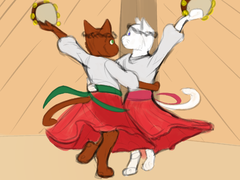
Given the hardships of Tajaran life and the constant need to do work by hand, the peasantry came to favor practical, well-insulated clothing rather than fanciful designs; they were also cheaper to weave, which made things easier on the weaver. Underwear usually came in the form of long-sleeved pants and a shirt typically woven from thick animal furs and plant fibers and is used as the innermost insulating layer. Then, a Tajara would overlay multiple garments to create several layers of insulation to stop the loss of body heat. Thick, full-length skirts, pants, and shirts were favored by the peasantry, all in dark colors to retain heat better. Typically pre-discovery and even post-discovery modern clothing consist of thermal underwear, pants for men or long, heavy skirts for women, with thick sweater-like shirts and fur cloaks.
The feared enforcers of the nobility wore great suits of armor designed to seal the user inside, creating an environment completely isolated from the harsh snows of Adhomai. Build for brute strength rather than comfort, the helmets of these suits made no room for Tajaran ears. These 'Enforcer Shells', as translated from Siik'maas, were usually brown or olive in color, with slit visors masking the wearer's face, they were also remarkably flammable and largely abandoned during the initial stages of the first revolution.
Today, the government officials of the People's Republic of Adhomai are usually seen dressed in olive military fatigues, occasionally donning a commissar-styled cap. These caps are usually styled with small rosettes to signify authority. When in especially cold weather, officials usually layer on black trench coats and scarves rather than wearing the outfits of the lower class.
The lower and middle class of the Tajara are better heated by proxy, and can comfortably wear flat caps and long-sleeved buttoned shirts for warmth when working in their factories rather than excessive garbs. When outside, typical Tajara wear bomber jackets or fur coats with additional fur padding on the interior to better trap heat, paired with traditional slacks. Headwear for these working-class citizens usually comes in the form of full head scarves to keep ears warm when in the wilderness, and standard soft and flat caps within cities.
Cuisine
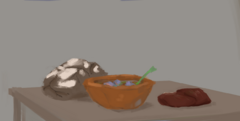
Similarly, due to the cold temperatures of Adhomai, Tajara favor warming or hot food that can be consumed quickly before the freezing winds can cool the meal off. Porridges, soups, and chowders consisting of diced meat and vegetables for flavor were the usual meal of a working-class Tajara, coupled with some bread and water or ale. Pre-industrial Tajara used to have community meals around bonfires to keep their food from cooling off too much, and almost all of their food source came in the form of porridges and oats. However, with the introduction of new technologies - such as higher quality insulation and home heating systems - Tajaran cuisine is being experimented with by chefs who are no longer restricted to compensating for the naturally low temperatures of Adhomai. Historically, culinary creations were reserved only for the nobility, who had better-heated homes than the peasantry, and more leeway was offered towards not having your meat turn blue in front of you.
Traditional stews are made with diced vegetables, such as Nif-Berries, and meat, Snow Strider is commonly used by the rural population, while industrialized Fatshouters' beef is preferred by the city’s inhabitants. Tajaran bread is usually made with Blizzard Ears' and consumed during their morning meals.
Adhomian alcoholic beverages are made with fermented grains, fruits, or vegetables. Juices are commonly mixed with sugar or honey. Victory gin is the most widespread alcoholic drink in Adhomai, the result of the fermentation of honey extracted from Messa's tears, but its production and consumption are slowly declining due to the loss of the People's Republic's hegemony over Adhomai. Messa's mead is also another more traditional alternative; it is made with honey and fermented Earthen-Root juice.
Fishing and shellfish have a part in the diet of the population in the coastal areas, even if the ice can be an obstacle to most experienced fishermen. Spicy Ras'val clams, named after the sea, are a famous treat, being appreciated in other systems besides S'rand'marr.
Notable Dishes
- Adhomian Hard bread: a type of Tajaran bread, made from blizzard ears’ flour, water, and spice, basked in the shape of a loaf. It is known for its hard crust, bland taste, and long-lasting nature. The hard bread was usually prepared for long journeys, hard winters, or military campaigns, due to its shelf life. Certain folk stories and jokes claim that such food could also be used as artillery ammunition or thrown at besieging armies during sieges.
- Fatshouters Bloodpudding: a mixture of Fatshouters meat, offal, blood, and blizzard ears flour served in the shape of a flattened sausage. This recipe dates from the early Tajaran history, a favorite among the peasantry due to its simplicity and easily obtainable ingredients. It can be eaten during all meals and occasions.
- Sugar Tree Candy: a literal translation of the popular Adhomian hard candy, found everywhere on the planet, from crystal plates in Crevus’ casinos to a bowl on a grandmother's table. Sugar candy is made from the Nm'shaan, and is a cheap, beloved treat for anyone on Adhomai to rot their teeth on. It's occasionally flavored with fruits or savory liquors.
- Avah: used to only mean "sweets" or "sweet thing," now singularly refers to a particular dessert. The batter is grilled and made into soft, spherical shapes, and then covered with fruit jams, sugar, or sweet cream cheese. These treats are often sold at festivals and celebrations, and foreigners compare them to pancakes.
Notable Beverages
- Messa's Mead: a fermented alcoholic drink made from earthen-root juice and Messa's tears leaves. It has a relatively low alcohol content and characteristic honey flavor. Messa's Mead is one of the most popular alcoholic drinks in Adhomai; it is consumed both during celebrations and daily meals. Any proper Adhomian bar has at least a keg or some bottles of the mead.
- Earthen-Root Juice: a juice made from the Earthen-Root. It is known for its blue color and sweetness. Because of its simplicity, Earthen-Root juice is one of Adhomai's most widely consumed drinks. Carbonated versions were created during the interwar period. However, the soft drink variation is not as popular as the traditional ones.
- Nm'shaan Liquor: an alcoholic drink manufactured from the fruit of the Nm'shaan plant. It usually has a high level of alcohol by volume. Nm'shaan liquor was once reserved for the consumption of the nobility; even today it is considered a decadent drink reserved for fancy occasions. It is commonly diluted with ice water before being consumed.
The Arts
Of all arts, music is one of the most highly valued by Tajara. Stemming from the long-standing ban on most literature in their society, song, and dance remained one of the only ways for Tajara to express themselves through words. Composers and musicians were traditionally held in high regard amongst Tajara, and in place of books, the fanciful song-stories of traveling bards were one of the few ways the public could remove themselves from their lives.
Theatre was also equally important in the life of a pre-discovery Tajara. Given that, with the lack of books, there was little to keep your usual worker entertained, the ability to watch and enjoy a riveting drama or hilarious comedy was heaven. Theatres and performing halls can be found in almost every Tajaran village, and are often constructed to rival even the main seat of the town council or government in architectural beauty. For example, the D'na'tel Hall in the Nal'tor was one and a quarter larger than the seat of government prior to human-sanctioned expansions. Dating back to the late Gunpowder Era, it was constructed from high-quality marble and many sculptures of characters and scenes from various popular Tajaran plays were meticulously hand-carved into the walls by sculptor Nasir Ka'nira.
However, literature itself - that is to say novels - has never been looked kindly upon by the Tajara public. Though this closed way of thinking is starting to shift with the greater introduction of literacy amongst Tajara as a whole, many elders still harbor bitter feelings about books in general. They were almost universally considered a symbol of oppression and luxury by pre-revolution Tajara, given the fact that only the nobility was taught en masse how to read, and that every family had its own private expansive library from which even learned peasants who had to pay out of pocket to access. This led to the widespread destruction of much of historical Tajara texts following the uprising, as revolutionaries took it upon themselves to purposely gather and burn whatever books they could after taking a noble stronghold.
Traveling circuses have been present in the Tajaran culture since ancient times. Joining a troupe was one of the few available ways for a Tajara to escape the rigid roles of the caste system. Performances usually include trained animals, acrobatics, storytelling, puppetry, strength displays, magic performance, creep shows, and stores selling all kinds of food and curiosities. Since circus schools only started to appear after the First Revolution, artists frequently transmitted their techniques to their pupils. Due to the previous conflicts and the ongoing cold war, wandering troupes face large barriers than ever before. Some of the biggest circuses have left for the stars in search of a more welcoming audience than Adhomai.
Music
Tajaran music is modally based, with there being eight modes in total. A scale can be constructed from each Mode, which is the arpeggio of the mode. There are a total of four notes in one modal scale. Two are octave, and there are two in between. Microtones between the two notes in between are used frequently, which would sound very odd to human ears. This is done because Tajara perceives music as sadder with the flatter a pitch is, and happier with the sharper a pitch is. Depending on the mood of a song, a Tajara player may tune their instrument lower, to make the song sadder; the opposite is also true. A common tradition is to let the weather decide the tuning of an instrument. Cold weather naturally makes an instrument flatter, ergo colder weather makes songs sadder. And indeed, one may notice that if each note is perceived relative to the notes that come before it, there is always a happy and sad part integral to the song. This is on purpose, as it reflects the duality in sadness/happiness which is also found in S’rendarr and Messa. Some Tajara may also associate Dissonances with Raskara.
The eight modes are respectively named: Mrazur, Manur, Rrauor, Surour, Kaoel, Draeol, Aauol, Deor. They are associated with the main Ma’ta’ke deities: Mata’ke, Marryam, Rredouane, Shumaila, Kraszar, Dhrarmela, Azubarre, and The Dead Gods.
A side effect of the Tajaran caste system is the possibility for the ethnicities to usually have different possible ranges and timbres on their voice. Zhan-Khazan are commonly a Bass-Baritone voice. Hharar are Tenor-Alto. M’sai and Njarir are almost always Sopranos. The voice is the most universal Tajaran instrument. Due to traditional schooling, many children have at least basic singing skills, though this is fading away in the cities.
Notable Folk Instrument
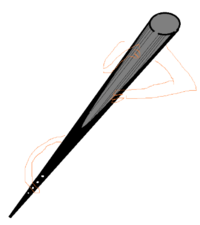
- P'rrama: a plucked string instrument, with eight strings and four holes at its end. The holes on the bottom change the octave of the notes that are played, thus extending the range of the sounds. It is used both solo and with other instruments. Humans can play it, but the octave range is disabled due to a lack of a tail.
- Makkra Baq: this instrument hails from the island of Das'nrra, but it has long been a staple of Tajara everywhere. One plucks the strings, creating a meek and Harpsichord-like sound. It is almost always used in a solo or duet setting, as its small voice can easily be overshadowed by other instruments. In spite of this, it maintains quite a folky sound, and it is more common in rural areas than in cities.
- Mah Kii: the Mah Kii is an ancient instrument, used by Tajara since the Migration Period. Adapted from a horn used to rally soldiers, it has a strong divine connotation. Many believe that one hears its sound when entering the Holly Village or when joining Messa in the afterlife. Rhazar’Hrujmagh caravans still use this trumpet at the start of raids. Some have even attempted to incorporate it into Electro-Swing bands. However, due to its short-range and its connotation with the divine, it is not used often.
Sports and Games
Recreation time for most Tajara has always been limited. Oppressive work hours and strict caste rules disallowed leeway for what a Tajara could do in their free time. Organized sports were a product of the Njarir class, which would find themselves with more time on their hands. However, as time marched on, Tajara of lower classes found ways to still play. In modern times, any Tajara is usually able to participate in any sport they wish.
Tabletop RPGs and wargames are popular for Tajara in urban centers. The Tajaran tradition of storytelling lent itself to these games being easily understood and quickly enjoyed by players who saw them as an evolution of the tales that priests shared in their communities. The tabletop scene sprouted a few years following the First Revolution’s end with Siik’maas translated versions of human and skrell tabletops. These were adapted later into localized versions that then became entirely Tajaran systems. The most well-known of these games is “Global Conquest”, originally made by the PRA and then adapted by DPRA and NKA companies, this board game replicates the conquest of Adhomai by different armies. Another is “Explorators of the Unknown”, a modular game where players play as characters exploring or investigating a world of their design.
The notion of video games is unknown to the natives of Adhomai; as computers are usually seen as tools. However, the younger generations living in Little Adhomai have taken interest in electronic games and arcades. Many independent productions have started to appear, with software being shared through the extranet or data storage devices. One popular title is "The Bane of Rashashana": which follows the tale of an Adhomian folk hero attempting to save her village from a malicious monarch. The player can make narrative choices that affect the story, interspersed with objectives such as running and managing a limited time meter while avoiding obstacles.
Notable Sports
- Farehal: a sport focused on accuracy. It consists of the player throwing a disc through several hoops scattered around a course. The distance and the difficulty of the shoot influence the score. The player with the highest point value wins. Due to the amount of space needed for Farehal, especially for multiple matches on the same course, due to this, it was only practiced by the nobility at first. Large buildings were constructed to host Farehal, where noble competitors played. This game is seen as extremely pretentious, with critics claiming it requires no real strength or skill to win. It has not seen much popularity outside of S'rand'marr, but it is moderately popular on Adhomai, with players in the PRA and a larger following in the NKA. Al’mari Hadii used to be a famous Farehal player.
- Mahmrro: a sport requiring the Tajara to capture a ball and either run it to the opposite side of a field or throw it to a team member located on the other side of the field. This game is very popular among the youth of any Tajara generation, mostly with the lower class. It is very decentralized and has any number of regional rules depending on where you are. Mahmrro came to be associated with the lower classes towards the end of the Steeple Peace. This attitude is visible in the NKA where nobility largely avoid playing the game. Leagues exist in every country for the game with these Mahmrro Clubs gaining much fame.
- N'hanzafu Roping: a sport created by the rock nomads, commonly used to settle disputes. Two or more riders can participate. Using Zhsram as their mount, they have to capture a N’hanzafu calf with a lasso and complete five rounds around a circular arena with it. Competitors are allowed to knock down each other or steal the other’s rope, but weapons are strictly forbidden.
- Baghrar: an ancient martial art from Adhomai primarily used for sport and contests of strength. The fighting style consists of strikes against the opponent from the waist up. The form of the attacks is primarily swiping motions that take advantage of a Tajara's claws to rake an opponent's torso or head. Other moves include punching for friendlier matches or stabbing forward with the claws in typical confrontations. Modern Baghrariri, or people who practice the Baghrar style for sport, usually fight with implements that cover and support their nails to avoid serious bodily damage. Modern Baghrar fights are decided upon with a point-scoring system over three 10-minute rounds, but historical victories were secured by knocking opponents onto the ground. Baghrar has been adapted into several different styles used by Adhomaian police and army units.
Notable Games

- Suns and Moon: a very common dice game. It is played by all, though the lower classes have the tendency to gamble whereas the upper classes play it just for fun. The ease and universality of the rules have garnered it quite the reputation. Die usually has an image of Rredouane fixed upon them. Parks commonly have designated spots for people to play Suns and Moon. Disputes are also solved through this game.
- Traiaz: a game mixing intellectual and dexterity play. The board is similar to chess, though it is considerably longer, with a lot of extra space in the middle. All 10 pieces are essentially pawns, though each pair has a catch. Pieces are captured by moving horizontally on the board. Some pieces can only capture when moving diagonally, vertically, or sideways. There are several distinct regional rules influencing what kind of movements are allowed. A match is decided after all pieces have been eliminated.
Military
The military hardware of the Tajaran nation is somewhere close to what humankind used in the 1900s, though the transition to energy weapons has already been made. Clumsy overheating handguns and rifles that slowly fire long bolts of concentrated energy are used by high-ranking soldiers or special operatives, but their durability is dubious in comparison to the mass-produced, single-shot or bolt action rifles that the majority of Tajaran soldiers use. In recent years the People's Republic has largely replaced bolt action rifles with fully automatic Tsarrayut’yan rifles, however, these suffer accuracy issues at longer ranges. Bayonets are heavily relied upon in close-quarters combat rather than Tajaran model submachine guns, which are expensive in the eyes of the People's Republic and jam easily in the harsh terrain of Adhomai.
Heavy infantry weapons like heavy machine guns used to come in the form of heavy, hand-cranked gatling emplacements with a heavy emphasis on frontal gun shielding. These HMG emplacements are extremely deadly in comparison to the slow-firing rifles of foot soldiers and are usually countered by Tajaran artillery or laser weaponry. Most squads of Tajara now carry a mixture of top-loading magazine-fed light machine guns or quicker-firing belt-fed LMGs.
Tajaran artillery is where the cunning of the People's Republic engineering shines, and many mountain ranges of Adhomai have been lined with massive artillery guns. These weapons fire devastating artillery rounds capable of leveling small camps with a single shot, let alone a barrage. Artillery vehicles and mortar teams are almost always deployed in tandem with Tajaran infantry in order to shell enemy entrenchments and positions, and many Tajaran tacticians utilize artillery as their main killing force. These weapons are the pride of the People's Republic, and their nightmare if lost to enemy hands.
For more information, see Tajaran Military Structures
Education
Tajaran institutions for education are woefully behind their counterparts in other species. Historically, Njarir’Akhran were often the only ones who became literate. Historians theorize this is tied to their alleged rise to nobility through their positions in early theological organizations. Officials from each faction agree that religious education has dominated most of Adhomai's academic history with heavy evidence from religious books which were largely able to survive the mass destruction of books by being sheltered in temples. Disagreements among academics arise when discussing the evolution of primary schools, secondary schools, and universities. Academicians in the New Kingdom of Adhomai assert that these institutions began to raise thousands of years ago during the Gunpowder Era and downplay the role of the nobility's suppression of educating the masses. However, intellectuals in the People's Republic of Adhomai and the Democratic People's Republic assert that these institutions were disingenuous social clubs at best and that schooling and formal education did not begin to arise until five hundred years prior. Hard information on the curriculum of pre-war institutions outside of theological institutions is difficult to find, however, archaeological evidence tends to support arguments that there was a heavy focus on the arts- especially musicals. Some artistic Hharar who lived before the war give accounts on nobles providing large patronage for painters such as in the modern sense with Al-Manq, but also for lavish concerts, operas, and ballets. Sculpting also came into prominence as evidenced by the intricate detail of various statues and gargoyle-like protrusions from an array of buildings in Nal'Tor and especially on the capital building in The People's Square: the aptly-named Steeple. Regardless of the details of pre-revolution educational institutions, the current face of Tajaran education outside of seminaries is primarily technical schools that focus on preparing young Tajara to work the various labor jobs around Adhomai.
Marriage and Relationships
Historically, the peasantry made due by uniting themselves as a workforce which has bred an intimate inter-person relationship among the families of most villages, towns, and cities. Regardless of the size of the population, pre-uprising Tajara were often well acquainted with families that may have lived on the other side of town. Arranged marriages were extremely common and were ways to improve relationships among families. However, this traditional practice has met with extreme criticism following post-uprising debates. The practice of arranged marriage was not feasible following the first revolution which effectively eliminated a generation of adult Tajara. This created a generation that had to largely create their own marriages, many of which passed on this emerging cultural norm to the next generation. Although the permanent pairing of Tajara is often colloquially referred to as "marriage" due to humanizing influences, there are a handful of different technical terms for it depending on the religion of the Tajara involved. S'rand'marr worshipers are typically brought together in temples by their local Brother of the Sun in a ceremony that symbolizes and glorifies S'rendarr and life. Their equivalent of Marriage is called "S'rendal'Matir" (The life of S'rendarr), named for the idea of continuing the life that the sun god S'rendarr celebrates. Tajara under the worship of Ma'ta'ke have a less celebratory and less ritualistic ceremony, instead, they have a simple meeting between families with a clergyman to proclaim the lovers "Zrrazhil Ekrratul" (Continuation of the families), named for the simple notion of propagating the blood of the families involved.
Throughout history, the concept of gender in Tajara society varied over time. Archaeological evidence suggests that before the Incarnate Dominion, multiple identities—often related to religious practices—existed. Like everything else, the nobility's breeding project also molded the perception of gender in Adhomai. Njarir’Akhran, with their great emphasis on their bloodline, were the ones with the strictest and defined gender roles. While the Zhan-Khazan rarely cared about these definitions, seeing little distinction between them. After the revolution, gender in the Tajara society changed as well, but it did not free itself fully from the shackles of the pre-contact oppression.
In history, transgender Tajara were more common among Njarir and Hharar due to their more defined gender roles. Before the revolution, these individuals were often in a nebulous state, as they were still obligated to participate in the eugenics program. While some could still find suitable partners, others had to find other outlets, such as joining religious societies or becoming outcasts. Ma'ta'ke priesthood is open to transgender Tajara who identify as their patron god's gender. The Church of S'rand'marr rejects these notions and maintains a strong distinction within its organization based on the gender assigned at birth of its members.
Third gender and nonbinary identities have historically been associated with religious and mystical perspectives. Those who could combine and balance both aspects were typically priests or mystics, known to have achieved some form of enlightenment. Only after the revolution are these identities now explored without the trappings of the occult. The older generations are usually confused by younger individuals who identify as such, with more religious Tajara being outraged at them for appropriating something that was once sacred.
Sexual orientation was a poorly defined concept for the Tajara until the contact. With the emphasis on the caste system, most individuals were expected to have a partner of the same ethnicity with whom they could reproduce, despite their preferences. The nobility often persecuted any relationship or behavior that threatened the caste project. The nobility strictly forbade any kind of relationship with a Tajara of a different ethnicity.
After the civil war, theories and studies about gender and orientation have begun to emerge among revolutionary thinkers. The most radical theorists argued that such concepts were constructions of the old nobility to further their control, calling for forgetting such ideas in favor of new visions. Currently, the Tajara society still upholds gender roles similar to those before the contact, mainly based on one's heritage. The concept of a defined and clear sexual orientation is still fairly new. Only now free of the oppressive Njarir system, the Tajara are free to think about these matters as they develop further socially, even if frequently tainted by the lingering old prejudices. The other species' vision of these matters is seen as alien; even a traditional Tajara would not care to pass judgment on anything that does not involve their people.
Because of the Tajara's recent history as a repressive, conservative species, they still carry many prejudices from the period before the revolution. Overt displays of affection, xenophilia, and interracial relationships among Tajara are looked down on and treated as deviancy. The pre-contact nobility purposefully encouraged these sentiments to further preserve the caste system.
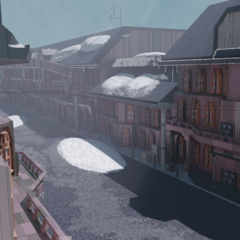
Architecture
Adhomai's architecture is marked by the swift historical changes that the planet suffered in the past decades. Pre-contact buildings - ostentatious monuments built by the Njarir'Akhran and wooden hovels inhabited by peasants - stand alongside modern edifices constructed by the early People's Republic and the modern Tajaran nations. Because of the destruction brought by two global conflicts, the Tajara had plenty of opportunities to experiment during the reconstruction. Most urban landscapes are a mosaic displaying the styles of whoever controlled them at a given time.
Holidays
Tajaran holidays center around the celebration of their nations, faith, or community. Many of these holidays have existed for centuries if not millennia, with a host of smaller rural holidays which vary from village to village. While priests of the Ma'ta'ke pantheon and the Parivara alike speak out against holding non-Tajaran holidays on Adhomai, such as Nal'tor's annual Halloween fundraisers, the vast majority of Tajara are usually indifferent towards celebrating these holidays when in Tau Ceti or other alien systems. Denying an invitation to a celebration for an alien holiday is still considered rude. Only hardliners become angered at the idea of celebrating non-Tajaran holidays off Adhomai.
- Armistice Day (November 26th): while the signing of the Armistice had led the nations to declare its date a holiday, the hopes for massive celebrations for the first anniversary were crushed quickly. The Solarian collapse had diverted the attention of the Tajaran governments towards trying to ensure their people in Tau Ceti were safe. Despite this, smaller and personal celebrations of the signed peace were still held on Adhomai. For the Tajaran community in Tau Ceti, Armistice Day became a symbol of unity in the face of the Solarian incursion. Rival gangs and communities set aside their differences and prepared for a possible invasion of Biesel together, a unity that unfortunately did not last after the rogue fleet was pushed out.
- Ma'ta’kyr (March 24th to 30th): for an entire week, followers of the Ma’ta’ke pantheon hold celebrations for their gods. The first day is for Azubarre, which is filled with dazzling performances and unsurprisingly marriages. The second day is for Dhrarmela, whose followers present well-made crafts to donate to their community. The third day is Kraszar, whose priests hold elaborate theatre performances to tell stories and share wisdom with the people. The fourth day is Shumalia's, and is spent repairing the broken homes of the poorest while also ensuring important buildings are maintained. The fifth is Rredouane’s, and a day consisting mostly of war stories and gambling. The sixth day is Marryam’s, where families spend the day connecting with one another and holding personal celebrations. The final day is dedicated to Mata'ke. It is on this day that an enormous fair is held within a community, organized by all Ma’ta’ke pantheon priests, celebrating the splendor of Mata’ke and his fellow gods. Within urban centers these fairs can become massive, sprawling over blocks and streets. D6’s Mata’ke following population celebrates this week fully, with workers taking days off or reduced shifts to enjoy it.
- Coming of Dawn (January 9th): a holiday commemorating the founding of the modern Parivara, the Coming of Dawn is when the worshippers of the Suns pay respects to Dirrnavirr'Almalik. Proclaimed as the prophet of the Suns, priests share stories about Dirrnavirr’Almalik’s history from his birth to establishing the Dominion of southern Ras’nrr, the first empire. It is said that it was there that he spread the faith of the suns and the priesthood was established and entrusted to guide the Tajara people. Services include performances from choirs and communal singing led by priests. Idols were once brought out depicting Dirrnavirr’Almalik, a Njarir King. Many of these icons were smashed apart in the First Revolution. What few still exist are artifacts in museums, kept in Sana Sahira, or brought out in Kaltir lands where the practice continues. The echo of the choirs can be heard wherever this is held, and within D6 one could hear the ringing of hymns throughout the entire district.
- Dholma Festival (Third Week of October): a week-long celebration to honor the harvest and prepare for the oncoming winter. During this period, Tajara will participate in large communal feasts, food fairs, and alcohol festivals. Drinking, eating, and spending time with friends and family are the main activities during this period; religious Tajara also visits local temples to offer donations to thank the Gods for the bountiful harvests.
| Tajaran Lore Pages | ||
|---|---|---|
| Species and Ethnicity Lore Pages | Tajara · Tajaran Ethnicities | |
| Planet and System Pages | Adhomai · S'rand'marr · Hro'zamal · Gakal'zaal · Adhomian North Pole | |
| Culture Society and History Pages | Tajaran History · Notable Tajara · Ma'ta'ke Gods · S'rendarr and Messa · Tajaran Minor Religions · Tajaran Emigration | |
| Governments and Organizations Pages | People's Republic of Adhomai · Democratic People's Republic of Adhomai · New Kingdom of Adhomai · Tajaran Military Structures · Tajara Space Capability · Crevus · Little Adhomai · Free Tajaran Council · Tajaran Educational Institutions | |
| Lore Arcs | Tajaran Cold War Arc · Bad Moon on the Rise Arc · Ghosts of War Arc · Cold Dawn Arc | |
Al'Mari Hadii picture created by SleepyWolf








